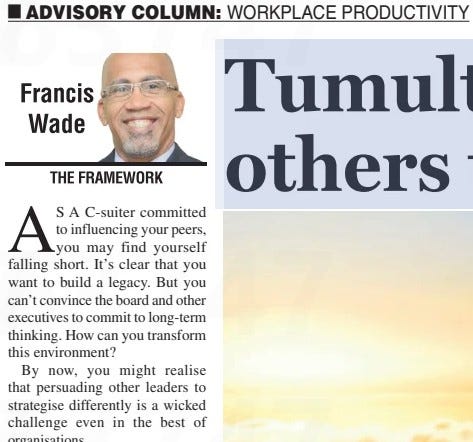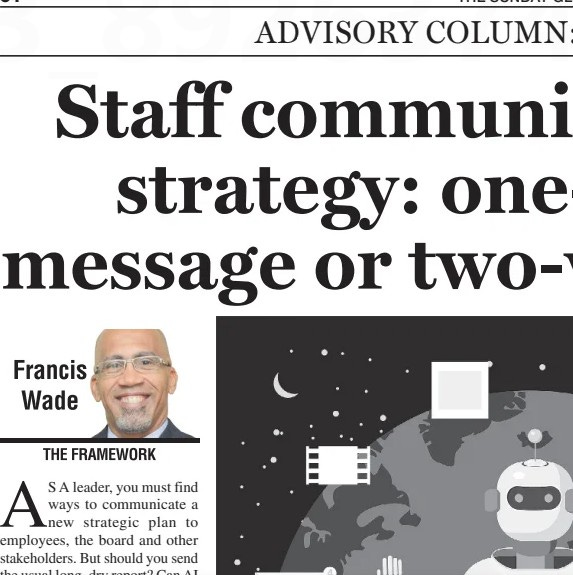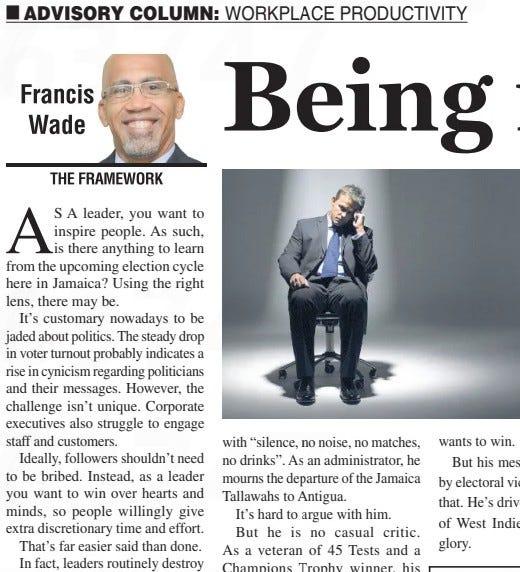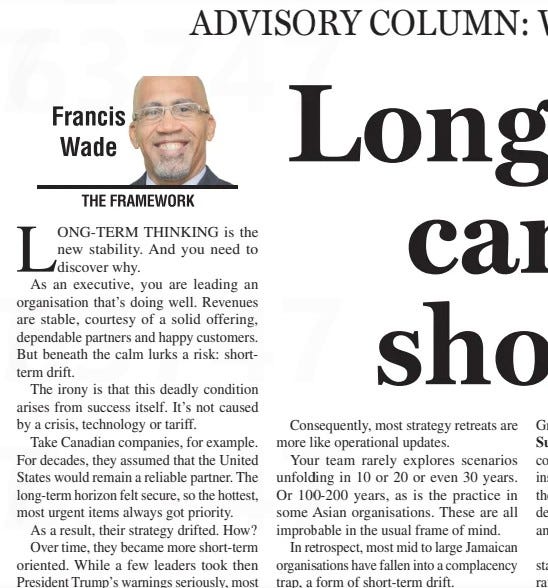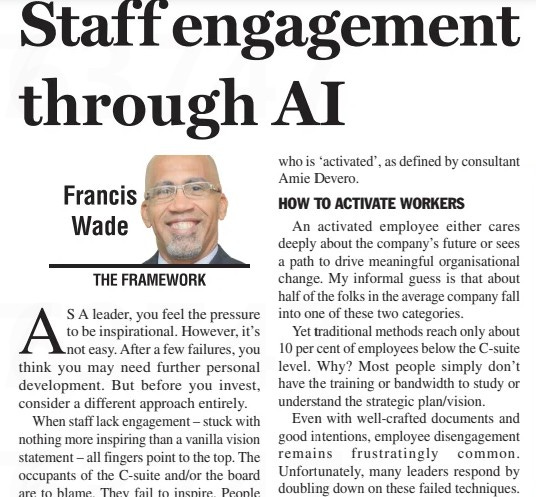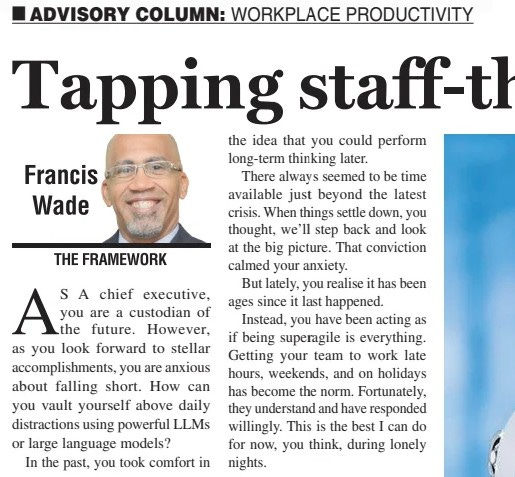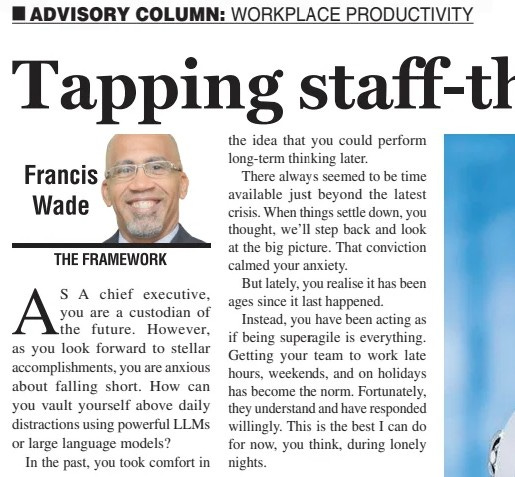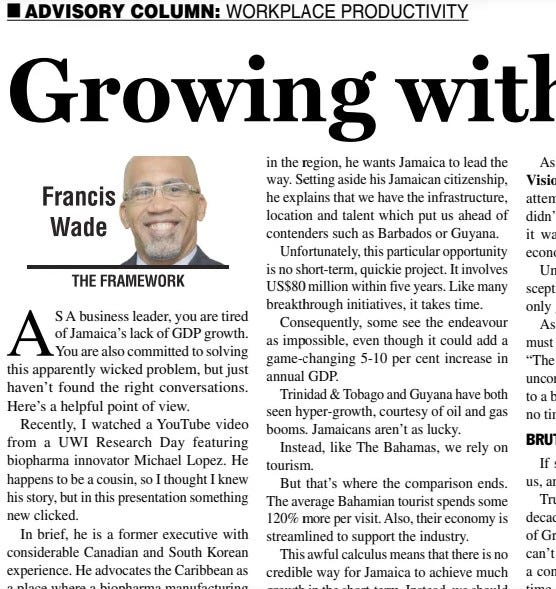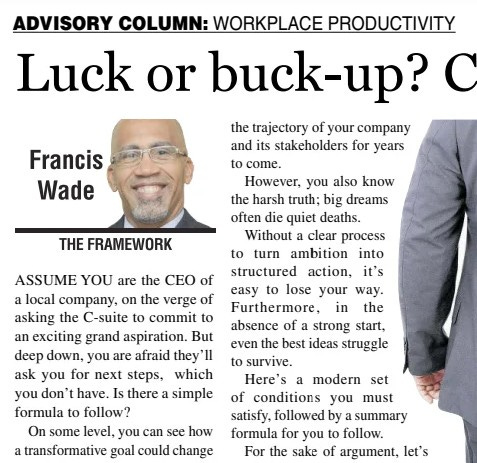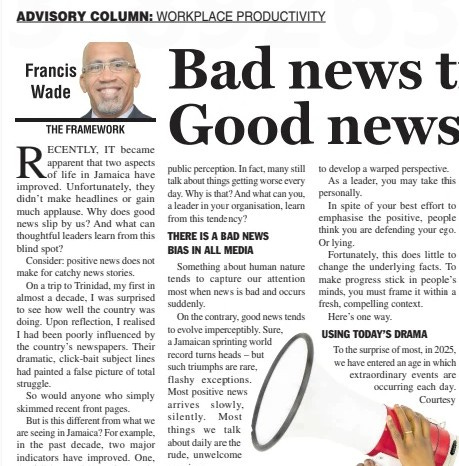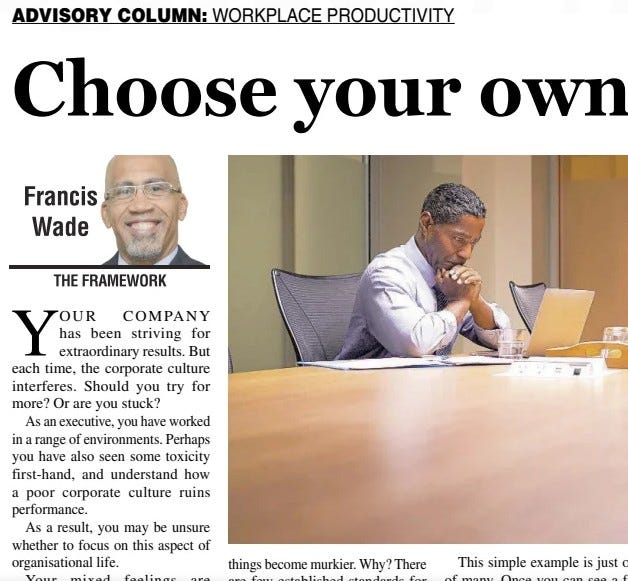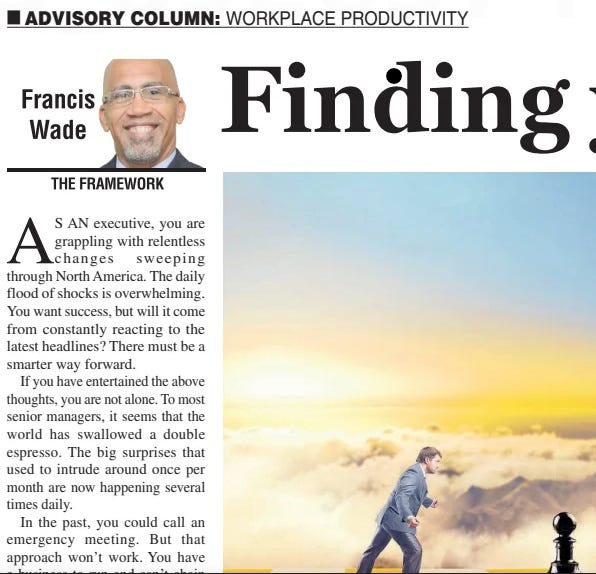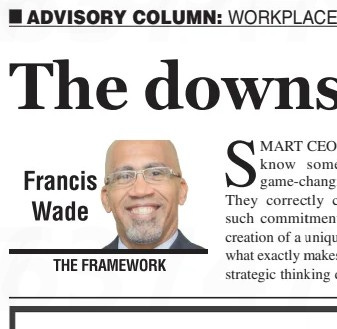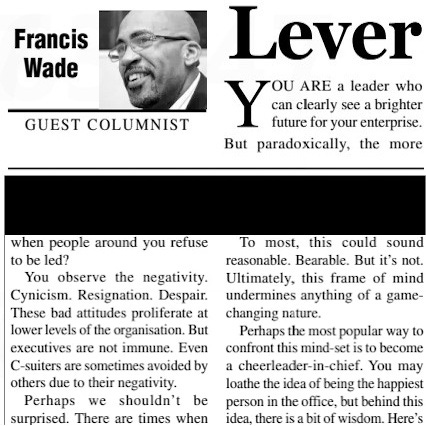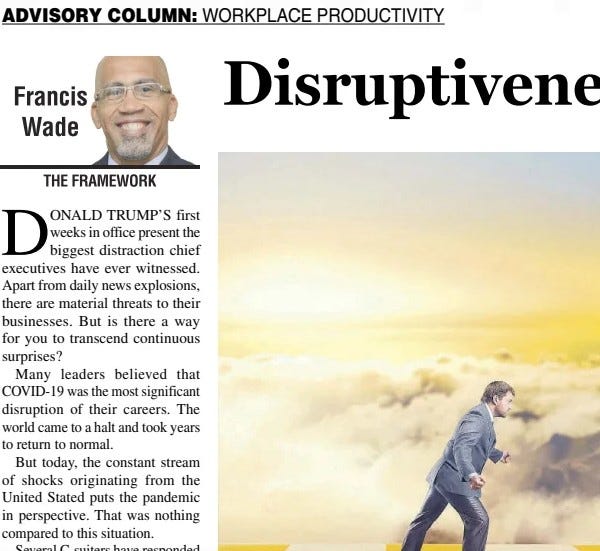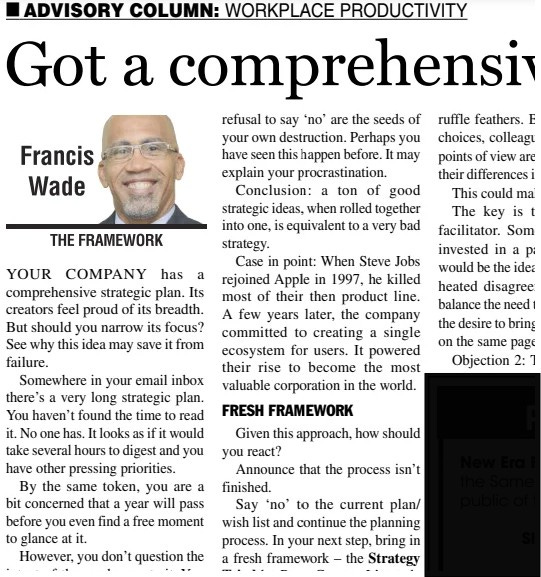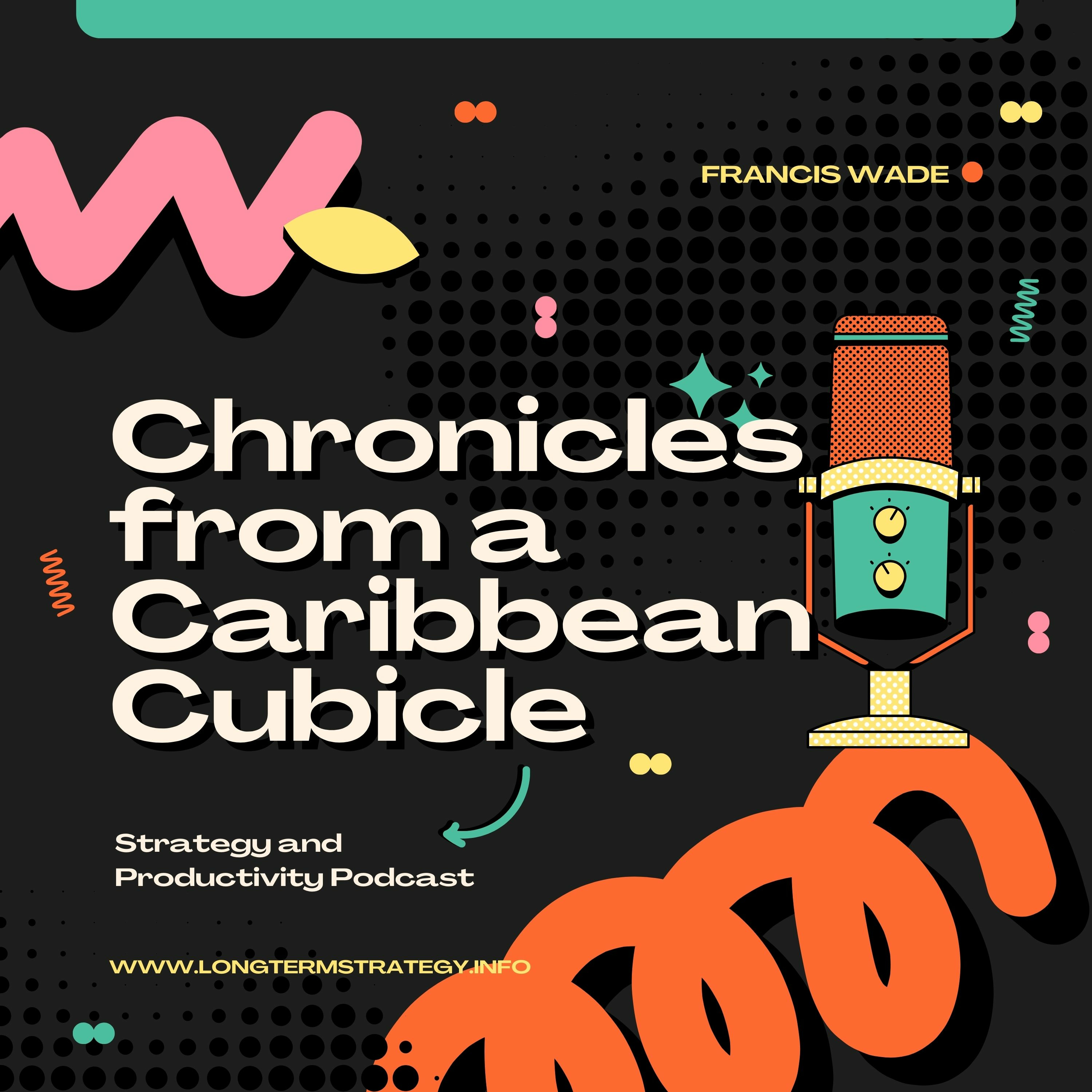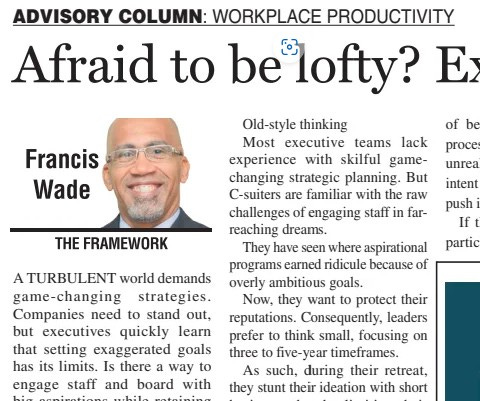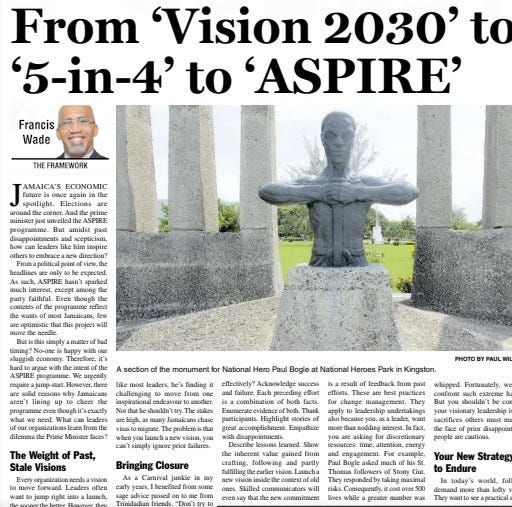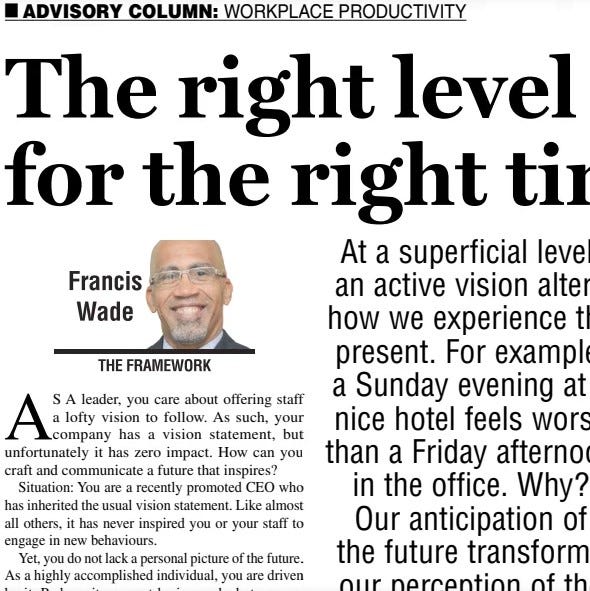Discover Chronicles from a Caribbean Cubicle Podcast
Chronicles from a Caribbean Cubicle Podcast

Chronicles from a Caribbean Cubicle Podcast
Author: Francis Wade
Subscribed: 1Played: 7Subscribe
Share
© Francis Wade
Description
There are significant challenges facing Caribbean companies. In the areas of strategic planning and productivity improvements, unique thinking is needed to break out of historical norms.
But such thinking isn’t easy to find.
Join me, Francis Wade, for some provocative insights into the way I see these problems. These are mostly audio editions of past Gleanr articles.
longtermstrategy.substack.com
But such thinking isn’t easy to find.
Join me, Francis Wade, for some provocative insights into the way I see these problems. These are mostly audio editions of past Gleanr articles.
longtermstrategy.substack.com
120 Episodes
Reverse
As a member of the C-suite with a commitment to long-term success, you may find yourself at odds with the culture around you. You’ve come to realize that your role has subtly but fundamentally shifted. While others are chasing quarterly numbers, you’ve begun to see your job through a different lens: one of legacy-building. You’re being pulled into the future, tasked—whether formally or not—with the responsibility of stewarding the organisation across decades, not just financial years.But here’s the challenge: how do you bring others along with you? How do you persuade a board of directors, fellow executives, investors, and employees to prioritize the long game in a world of short-term incentives?This is not an easy undertaking. In fact, changing how leaders think about strategy is one of the most difficult challenges in any organisation—especially successful ones.The Resistance You’ll MeetTake a step back. The leaders around you didn’t get to the top by being slow or visionary. They were rewarded—often repeatedly—for producing immediate results. Many of them built careers by tackling crises, hitting aggressive targets, and outpacing competitors. To them, leadership is synonymous with rapid action and tangible wins.So when you start talking about “the next decade” instead of “the next quarter,” expect to encounter skepticism—or worse, indifference. You’ll find yourself talking about long-term transformation to people whose reputations, bonuses, and egos are anchored in the short term.Yet your instincts tell you that this moment demands something different. You’ve seen what happens to companies that delay the future. Think Netflix versus Blockbuster. Apple’s iPhone versus Nokia and Blackberry. You understand that anticipating and shaping what’s next is no longer optional—it’s essential for survival.When the Future Becomes Your ResponsibilityThe strange thing is, you probably didn’t sign up for this. Most executives aren’t formally tasked with long-range planning. You may not have a title like “Chief Vision Officer” or “Head of Strategic Futures.” But somewhere along the line, the burden of long-term thinking has landed on your shoulders. You are the unofficial guardian of the future.And while some rise to the challenge, others freeze. Some feel paralysed, unsure of how to move forward without formal authority or clarity. Others rationalize their inaction: “The world is changing too fast,” they say. “We need to stay agile, not idealistic.” Or, “We can’t focus on tomorrow when we’re struggling to meet payroll today.”Those may sound like pragmatic statements—but left unchallenged, they become excuses that entrench short-termism and degrade strategic clarity.You Might Be a LiabilityHere’s a difficult truth: if you’ve seen the need for long-term strategy and choose not to act on it, you may be doing more harm than good.Executives often see promotions as rewards for past performance. Some become preoccupied with proving they belong in the role. Others fall into the trap of “Imposter Syndrome,” second-guessing their right to think differently or challenge existing paradigms. And many double down on what worked in the past: more short-term execution, more urgency, more firefighting.But that’s not what your organisation needs from you now.Remember Kodak? At its height, it was a global juggernaut. But a failure to confront long-term realities cost it over US$31 billion in value and 128,000 jobs. The signs were there. What was missing was leadership willing to act on them.Persuasion as a Strategic SkillIf you’re waiting to take a course or attend a strategy retreat before acting, think again. The pace of change means you can’t afford to disappear for even a day without consequence.Instead, see persuasion itself as a mode of learning. Every time you initiate a courageous conversation with a colleague about the future, you sharpen your understanding. Use questions like:* “What’s the long-term impact of this decision?”* “What systemic issues are we failing to address?”* “What future trends are we not discussing?”* “What goals would inspire our stakeholders ten years from now?”* “Which breakthroughs are we ignoring because they don’t pay off this quarter?”These questions are disarming. They don’t require formal authority. But they do require courage.You’ll need to tailor your approach to your context—whether you’re in a multinational corporation, a government ministry, a non-profit, an educational institution, or a startup. The principles remain the same: be the voice of long-term thinking in rooms dominated by short-term pressure.Building Fluency, Not Just FaithYou may wonder whether it’s enough to just champion long-termism and let your enthusiasm carry the message.Unfortunately, no.If you’re not fluent in the arguments and counterarguments, you’ll be vulnerable to professional naysayers—those who use sophisticated logic to resist change. They’re often well-respected, experienced, and deeply invested in the status quo. Without preparation, they will derail your meetings, stall your initiatives, and seed doubt in others.So don’t stop at intuition. Build expertise. Study long-term successes and failures. Read case studies. Watch YouTube documentaries. Analyze how visionaries like Steve Jobs, Satya Nadella, or Zohran Mamdani frame the future in specific, compelling language. Study the language of leaders who inspire action across timeframes.Becoming fluent allows you to do more than make a good point—it allows you to win the room.Final ThoughtNo one is born with the ability to shift other minds from a focus on “this quarter” to “this decade.” It’s not a natural skill—it’s a deliberate one. But if you cultivate it, refine it, and use it consistently, you’ll help your organisation navigate the future with intention instead of reaction.Otherwise, you risk remaining a hostage—trapped by the logic of short-term thinkers and the inertia of yesterday’s success.Start the practice today. The future is waiting for your leadership.This article was rewritten based on an earlier Jamaica Gleaner column. This is a public episode. If you'd like to discuss this with other subscribers or get access to bonus episodes, visit longtermstrategy.substack.com/subscribe
As a senior executive, one of your most crucial and delicate responsibilities is the communication of strategic plans to employees, board members, and key stakeholders. But how should you do it? Is it enough to share a dense, one-off report? Or can AI finally offer a way to transform this traditionally frustrating task into something more interactive and engaging?Most leaders dread this stage of the strategy cycle. The excitement of a successful off-site retreat or board strategy session has passed. Now, the hard part begins: conveying the essence of the plan to those who weren’t in the room, yet are expected to bring it to life.The conventional approach hasn’t changed much in decades. First, circulate a written document filled with bullet points, jargon, and long-term goals. Next, convene a town hall meeting, supported by a string of PowerPoint slides. Questions are few. Attention drifts. Finally, you pass the baton to middle managers to cascade the strategy to their teams, hoping they convey the message with clarity and enthusiasm. Often, they don’t. Miscommunication spreads. Employees receive mixed signals. Strategic alignment becomes a fantasy.The result is predictable: confusion, disengagement, and inertia.The Communication GapWhy does this happen, even in well-managed companies?Because strategy is inherently difficult to explain. Unlike routine business matters, it deals with the future—a future that is unpredictable and unknowable. Strategic thinking requires executives to rely on incomplete data, make educated bets, and reason through complex interdependencies.Most employees, however, are trained to execute, not theorize. They want certainty. But strategy rarely offers it. It requires abstract thinking, conceptual frameworks, and trust in leadership judgment.To compound the problem, many employees have no idea what the company’s strategy is. Surveys routinely show that a significant portion of the workforce cannot articulate their organisation’s strategic direction. That’s not because they lack intelligence, but because the way strategy is usually communicated makes it inaccessible.The old approach—a top-down, one-way message—no longer suffices in a world where you are hiring for brains, not brawn. If your employees are going to make smart, real-time decisions that support the strategy, they need to understand the “why” behind the “what.”From Monologue to DialogueToday’s leaders must embrace a new mindset: communication is not just about broadcasting; it’s about engagement. The onus is no longer on the employee to decipher a static report or passively sit through a presentation. Instead, it is the executive’s responsibility to foster understanding—to create conditions in which meaningful dialogue can occur.Fortunately, advances in artificial intelligence offer new pathways. Specifically, large language models (LLMs) such as NotebookLM, a “Source Language Model,” can help transform strategy communication from a passive event into an interactive, personalised experience.What Makes NotebookLM Different?Unlike general-purpose AI tools that respond based on pre-trained knowledge, NotebookLM grounds its responses entirely in documents you upload. This means your actual strategy files—slide decks, board reports, workshop outputs—become the exclusive source of truth. The app processes your data, then allows users to interact with it intelligently.Here’s how to use it.Upload your strategic materials. These could include the formal plan, background analyses, executive summaries, transcripts or even FAQs.Design prompt sets for different levels of strategic maturity:Basic Prompts for new hires or employees unfamiliar with strategic planning. These focus on summaries, definitions, and the background story—ideal for onboarding or setting context.Intermediate Prompts for general staff. These might explore implications, comparisons, and potential challenges in execution.Advanced Prompts for experienced team members or high-potentials. These require synthesis across documents, evaluation of assumptions, or the generation of novel ideas based on strategic intent.The goal is to provide each employee with an opportunity to interrogate the strategy at their own level. Because the responses are personalised and context-aware, employees engage with the material in a way that suits their curiosity, experience, and role.Make It Playful and ChallengingTo increase engagement, you can even add a layer of gamification. Frame the interaction around a scenario—for example, “Play the Devil’s Advocate.” Ask staff to identify potential flaws, contradictions, or unspoken assumptions. Give their inputs scores or feedback. Celebrate insightful critiques.This simple, low-cost exercise can breathe life into a strategy document that would otherwise be skimmed or ignored. It empowers employees to participate in shaping strategic thinking, rather than being passive recipients of edicts from above.A New Era of Strategic EngagementWe are entering an era where employees expect more than a memo or slide deck. They want to understand the company’s direction, contribute ideas, and be involved in shaping the future. AI tools like NotebookLM don’t just allow this—they encourage it.For the first time, executives can enable a genuine two-way dialogue about strategy, at scale. They can foster a sense of ownership among staff who would otherwise feel excluded or overwhelmed.The days of rolling out a strategic plan as a one-way monologue are over. Embrace a model that invites curiosity, fosters understanding, and deepens engagement. With the right tools and mindset, your strategy won’t just be communicated—it will be understood, internalised, and acted upon. This is a public episode. If you'd like to discuss this with other subscribers or get access to bonus episodes, visit longtermstrategy.substack.com/subscribe
“Inspiration in Leadership | Anchor Your Message in a Compelling Future”As a leader—whether in politics or business—you want to inspire people. You want them to care, commit, and go above and beyond. But earning this level of engagement is difficult. In fact, it’s one of the most elusive challenges in leadership.Inspiration, after all, isn’t automatic. It doesn’t come from holding a title or issuing commands. It’s something that must be carefully cultivated, often against the backdrop of public skepticism. That’s one reason why political campaigns, like Jamaica’s upcoming election cycle, can offer unexpected leadership lessons—if viewed through the right lens.Today, many are disenchanted with politics. Voter turnout in Jamaica has declined steadily, echoing global trends that point to growing cynicism about leadership, institutions, and the future. And this problem isn’t confined to government. In the corporate world, executives also struggle to mobilize teams and customers around a vision—especially in environments marked by uncertainty, competition, and fatigue.Ideally, leaders shouldn’t need to bribe, pressure, or manipulate people into action. Instead, they aim to win over hearts and minds so that others willingly contribute their discretionary time, energy, and creativity. That’s what genuine inspiration looks like—but it’s easier said than done.Leaders, even well-intentioned ones, often destroy followership without realizing it. They lose focus, fail to articulate a compelling vision, or make careless remarks that erode trust. You’ve likely seen this happen—where someone in authority squanders goodwill with a single tone-deaf comment or decision.Amidst this leadership crisis, I recently came across a video from Wavell Hinds, the former West Indies cricketer and now a political aspirant with Jamaica’s PNP. His short Facebook message, filmed at a deserted Sabina Park, offers a masterclass in communicating a purpose-driven future—one that transcends personal ambition or partisan gain.Grounded in Painful TruthsHinds begins with brutal honesty: West Indies cricket has declined. Once the pride of the Caribbean, it now commands little interest or passion. For many young Jamaicans, he argues, the game no longer holds any allure because they never grew up seeing it at its best.Standing in an empty Sabina Park, once a symbol of cricketing greatness, he laments: “There’s silence, no noise, no matches, no drinks.” He speaks not just as a politician, but as someone who lived the dream—having represented the West Indies in 45 Test matches and winning a Champions Trophy.His message is credible precisely because it’s personal. Cricket, he says, was a vehicle for his childhood ambitions. Now, he mourns what appears to be its slow death in the region’s consciousness.Avoiding Cynicism and Cheap ShotsYet despite the raw emotion, Hinds avoids the kind of toxic finger-pointing that dominates many political messages. Yes, he questions the current government’s commitment, criticizing superficial gestures like ribbon cuttings and photo ops. But his tone isn’t bitter. He doesn’t vilify.“Where is the action once the lights and cameras are off?” he asks. The question lands—not because it attacks—but because it invites reflection.This is instructive. Too often, leaders believe they must attack rivals in order to stand out. But in both politics and business, overemphasizing competition can alienate your audience. Customers don’t care who your competitors are. Employees don’t necessarily rally behind a “we beat them” mentality. And voters? They grow weary of petty battles.The Power of a Shared FutureWhat people do care about is the future—and whether a leader has a credible, inclusive path to get there.Hinds doesn’t merely lament the past or criticize the present. He paints a vision of what could be: a resurgence of West Indies cricket that unites generations and rekindles national pride. It’s not about winning the next match or the next election. It’s about anchoring today’s actions in a future worth striving toward.For corporate leaders, this is an important lesson. It’s tempting to focus narrowly on market share, quarterly results, or outperforming the competition. But those goals rarely ignite passion. Instead, leaders must craft “probable futures”—like “Sustainable Manufacturing 2040” or “AI for Human Flourishing”—that spark hope and demand innovation.People don’t follow leaders because they outperform the competition. They follow those who offer a bigger vision—one that includes them, stretches their imagination, and makes them feel part of something meaningful.Become an Ambassador from the FutureEffective leaders speak and act as if they’ve already visited the future—and are now returning to guide us toward it. They describe what they’ve seen in vivid, practical terms. They acknowledge the obstacles, yes—but they also lay out a clear path forward.This kind of visionary leadership is difficult. It can be lonely. But it’s also the most fulfilling and impactful kind of work.So ask yourself: what future are you inviting others to help create? Are you giving them something worth committing to—not just because it benefits your organization, but because it matters to the wider world?The takeaway is clear: whether you’re in the boardroom or on the campaign trail, being inspiring is hard. But when your message is grounded in truth and tied to a compelling, collective future, people will follow—not because they must, but because they choose to. This is a public episode. If you'd like to discuss this with other subscribers or get access to bonus episodes, visit longtermstrategy.substack.com/subscribe
The Stability TrapYour organisation is doing well. Revenue is strong. Customers are satisfied. Partners are dependable. From the outside, all indicators suggest smooth sailing.But under the surface, a dangerous shift is taking place—short-term drift. Ironically, this subtle threat emerges not from crisis, competition, or disruption, but from long-term stability itself.Consider what has happened in Canada. For decades, Canadian businesses assumed their relationship with the United States—its largest trading partner—was rock solid. The long-term outlook seemed secure. So leaders prioritised immediate operational concerns over deeper, strategic ones.But when political shifts began to destabilise cross-border relations, many companies were caught off guard. While a few heeded early warnings from U.S. leadership, most dismissed the risks. That complacency became apparent only in hindsight. What they lost was not just preparedness—but the ability to think long-term in an environment that demanded it.This is short-term drift in action: the gradual and unconscious narrowing of focus to what seems most urgent, while neglecting the truly important.And it’s not just Canadian firms. This phenomenon is playing out across industries and borders.How “Success” Dulls Strategic ThinkingTake a moment to consider your own company. If you’re relying on a traditional five-year strategic planning cycle, short-term drift may already be taking root.Why? Because a five-year lens quietly removes anything further out from serious discussion. Questions about the world in 10 or 20 years—customer needs, technology evolution, global regulations, talent pipelines—fade from view. The long-term horizon becomes a foggy abstraction. In some Asian corporations, by contrast, planning horizons stretch to 100 years or more.In many mid-sized or large organisations, strategy retreats become little more than operational reviews dressed up with glossy presentations and smart-sounding goals. These so-called strategies are rarely the product of deep re-evaluation. Instead, they reflect a preference for safety and familiarity. Existing assumptions remain unchallenged. Difficult trade-offs are postponed.When the unexpected occurs—think pandemics, AI disruption, climate-related volatility or geopolitical conflict—the organisation is caught flat-footed. Recovery is often slow, sometimes impossible.A case in point: Intel. The once-dominant chipmaker was warned of competitive threats two decades ago. Founder Andy Grove even wrote a book—Only the Paranoid Survive—that outlined how close the company came to losing its lead. Yet that wasn’t enough. By the 2020s, Intel had drifted, allowing TSMC and Nvidia to outpace them in both innovation and growth. The result? A painful loss of relevance in an industry it once defined.Where True Stability Comes FromThe answer to this quiet erosion isn’t reactive crisis management. Nor is it simply extending your planning timeline.Instead, leaders must draw confidence and stability not from present success or external conditions, but from their organisation’s ability to think—and act—long-term.Here’s how:1. Challenge the Five-Year LimitThe five-year plan has become a default tool in many companies. But relying on it alone is a dangerous blindfold. Many known forces shaping your future lie beyond that window—demographic changes, technological revolutions, climate transformation, shifts in global power.To begin, surface long-term issues currently gathering dust in the boardroom. Think of trends everyone knows are coming—but no one is seriously discussing.2. Rehearse the Future with Scenario PlanningScenario planning offers a powerful way to break the tyranny of short-termism. Used in global institutions—and even to craft national visions like Vision 2030 Jamaica—this method allows teams to map a range of future possibilities and stress-test their strategies against them.Done properly, scenario planning becomes a kind of corporate rehearsal: the leadership team imagines what could happen, what the organisation’s instinctive response would be, and how a more prepared, visionary plan might fare.Such exercises reveal fragilities before they become fatal. And they generate resilience far more effectively than motivational slogans or “change readiness” workshops.3. Replace Positivity Theatre with Real CourageMany executive teams avoid long-term thinking because it’s uncomfortable. It introduces uncertainty. It invites pessimism. And it requires confronting possible failure.In some companies, a forced optimism takes root—“bring me solutions, not problems” becomes the motto. Dissenting voices are silenced in the name of unity. Difficult conversations are sidelined in favour of morale-boosting pep talks.But this denial of risk is not leadership—it’s theatre.Real leadership requires courage. Not the kind that wins applause, but the kind that invites scrutiny, tough questions, and occasional setbacks. It means accepting the possibility of reputational harm, negative press, or even internal dissent if it serves the long-term health of the organisation.Conclusion: Lead Beyond the Comfort ZoneShort-term drift is a subtle, silent threat. It doesn’t come with alarms or sirens. It hides behind strong earnings and confident forecasts. But it’s corrosive—and by the time its effects are visible, it may be too late.To guard against it, executives must replace passive stability with proactive foresight. Real strategy starts where comfort ends. It begins with asking the hard questions—about what lies beyond five years, beyond this market cycle, beyond current success.If you want to protect the future, build your strategy on vigilance, not victory. Reconnect your organisation to its long-term mission. Challenge today’s assumptions. Engage with tomorrow’s unknowns.Only then can you truly lead—not just for now, but for the decades to come.The above article is adapted from my regular column in the Jamaica Gleaner newspaper. This is a public episode. If you'd like to discuss this with other subscribers or get access to bonus episodes, visit longtermstrategy.substack.com/subscribe
TranscriptAs a senior executive, you’ve probably felt the weight of expectation when it comes to inspiring your team. The board expects it. Your direct reports need it. But despite your best efforts—the carefully crafted presentations, the all-hands meetings, the motivational speeches—something isn’t working.Your people seem disengaged. They nod politely during strategy sessions, but you can sense their minds wandering. The quarterly results suggest they’re just going through the motions rather than truly buying into your vision for the future.Your first instinct might be to blame yourself. Maybe you need better presentation skills, more charisma, or additional leadership training. But before you sign up for another executive coaching program, consider this: the problem might not be you at all.The Outdated PlaybookMost organizations still rely on industrial-age methods to communicate their strategic vision. The playbook hasn’t changed much in decades:Step one: Leadership team crafts a comprehensive strategic plan during an off-site retreat.Step two: Create a polished presentation and distribute lengthy PDF documents.Step three: Hold a company-wide meeting where the CEO delivers an inspiring speech.Step four: Trust middle managers to cascade the message down through their teams.Step five: Hope the enthusiasm lasts more than a few weeks.This approach assumes that inspiration works like a broadcast signal—send it out once, and everyone receives it clearly. But that’s not how human psychology works, especially in our current information-saturated environment.Consider this reality check: the average employee finds more engagement in a one-minute Tik Tok video than in most hour-long corporate strategy presentations. This isn’t a reflection of shortened attention spans—it’s about relevance and interactivity.Rethinking Employee ActivationInstead of trying to temporarily pump up your workforce, focus on creating what consultant Amie Devero calls “activated” employees. These are people who either genuinely care about your company’s future or have discovered how their personal aspirations align with organizational goals.In most companies, roughly half the workforce falls into one of these categories naturally. They want to contribute meaningfully and grow professionally. The challenge is that traditional communication methods only effectively reach about 10% of non-executive staff members.Why such a low connection rate? Most employees simply lack the background or time to digest complex strategic documents. Even when materials are well-written and intentions are good, the gap between executive thinking and front-line understanding remains vast.When leaders notice this disconnect, they often make things worse by trying harder with the same failed methods. They speak louder, write longer documents, and add pressure on middle managers to better “sell” the message.But what does a truly activated employee look like in practice?They regularly reference the company vision when making decisions. They have genuine curiosity about strategic initiatives and how their work contributes. Most importantly, they feel connected to colleagues around shared purpose rather than just shared tasks.The question becomes: how do you create this level of engagement systematically?The AI-Powered SolutionRecent advances in artificial intelligence offer a completely different approach to vision and strategy communication. Large Language Models—sophisticated chatbots that can engage in natural conversation—have opened new possibilities for organizational learning.More specifically, there’s a subset called Source Language Models that work exclusively with materials you provide. Think of it as creating a custom search engine that only knows about your company’s strategy documents, leadership videos, planning materials, and related content.Unlike general-purpose AI that draws from the entire internet, these focused systems answer questions using only your uploaded materials. This means employees can have detailed, accurate conversations about your specific strategic vision without getting generic business advice.The practical applications are remarkable. An employee wondering how their department fits into the five-year plan can get instant, detailed answers. Someone curious about market assumptions underlying your strategy can explore those topics in depth. A team member with ideas for improvement can understand exactly where their suggestions might fit.Modern platforms can automatically generate supplementary materials from your core documents: podcast-style audio summaries for commuters, interactive quizzes to test understanding, visual mind maps showing strategic connections, and even video presentations that break down complex concepts.Beyond Traditional EngagementThis AI-powered approach addresses several problems with conventional vision communication:Personalized pacing: Instead of forcing everyone to absorb information at the same rate during meetings, people can explore strategic concepts at their own speed and depth.Continuous availability: Rather than limiting strategic discussion to quarterly all-hands meetings, employees can engage with your vision whenever questions arise in their daily work.Interactive learning: Instead of passive consumption of presentation slides, people can ask follow-up questions, explore specific areas of interest, and test their understanding.Identifying blind spots: As employees interact with your strategic materials, they often surface insights that leadership teams miss. Front-line workers frequently spot emerging technologies, customer trends, or operational challenges that could reshape your industry.When this happens at scale, you essentially gain access to a tireless strategy consultant who knows your business intimately and never sleeps. Your AI system becomes increasingly valuable as more employees engage with it, asking questions that reveal both strengths and gaps in your strategic thinking.The Leadership ShiftThis approach represents a fundamental shift in how we think about inspirational leadership. Instead of placing the entire burden on executives to be charismatic communicators, it creates systems that meet each person where they are.Some employees learn best through detailed written analysis. Others prefer audio explanations during their commute. Still others need visual frameworks to understand complex relationships. An AI-powered system can serve all these learning styles simultaneously.The result is genuine activation rather than temporary motivation. When people can explore your vision on their own terms, at their own pace, they develop deeper understanding and stronger commitment.As a leader, this doesn’t diminish your role—it amplifies your impact. Instead of being limited by your personal bandwidth and communication style, you can reach every team member in ways that resonate with their individual needs and interests.The future of vision communication isn’t about becoming a more inspiring speaker. It’s about creating more engaging, accessible, and interactive ways for people to connect with your company’s purpose, strategy and direction.This article is based on my recent column (8-31-2025) in the Jamaica Gleaner newspaper. This is a public episode. If you'd like to discuss this with other subscribers or get access to bonus episodes, visit longtermstrategy.substack.com/subscribe
As a CEO or senior leader, you’re responsible for steering your organization into the future. But if you’re being honest, you may feel like you’re falling short. The day-to-day noise is deafening. How can you rise above it all and think strategically—especially now, when AI tools like Large Language Models (LLMs) are reshaping the game?In the past, you likely comforted yourself with a familiar belief: “We’ll think long-term later...once this urgent issue is behind us.” There was always supposed to be time—just around the corner—to lift your head up and see the big picture.But when you stop to look back, you realise: that moment never arrived.Instead, the pressure to be constantly reactive has taken over. Working nights, weekends, even holidays has become your team’s new normal. They understand the stakes. You’ve done your best under the circumstances. And yet, in quiet moments, you fear “It’s not enough.”You think of the companies whose leaders failed to plan for the obvious. Today’s executives in those firms are frustrated, pointing fingers at past C-suites who missed what, in hindsight, was plain to see.Consider the example of Digicel and its success in Jamaica since 2001. You can imagine the regret at Cable & Wireless. Or look at Canadian companies that relied too heavily on U.S. trade policies—only to find themselves exposed here in 2025. Think of Intel, struggling to compete with Nvidia and TSMC.In each case, when reality finally forced a wake-up call, it was too late.You might say, “But I trust my own instincts. I’ve pulled off miracles before.” That may be true. But today, that won’t be enough.Even if you locked yourself in a room with the best business thinker in the world, you’d still face a serious limitation: your competitors can now access smarter thinking faster. LLMs, paired with local, data-driven insight, are leveling the playing field. You’re not just competing with other executives—you’re competing with every team that knows how to ask better questions.That’s why strategy today is no longer about just having the “right” answer. It’s about involving your people in the process. Provoking new thinking from insiders who know the terrain best.Here’s how to do it.Rethink How You Prompt Your PeopleIf you’ve used LLMs like ChatGPT, you know: a well-crafted prompt makes all the difference. The same idea applies to your team. You need to move beyond weak prompts—like town halls, company retreats, or basic SWOT exercises.Instead, create what we’ll call an ultra-prompt. Start with these ingredients if you’re looking to revamp the way you hire top talent:* List 5–10 of your organization’s thorniest issues. Pick one—say, attracting top-tier talent under 35.* Gather internal data and case studies. Include hiring stats, exit interviews, culture surveys, pay equity reviews, and more.* Frame the issue differently. Teach a new lens like Jobs to Be Done or Category Design to shift how the problem is seen.* Form diverse, cross-functional teams. Mix tenure, departments, and seniority. Give them a focused 30–120 minutes.* Encourage the use of prompts for input in their LLM of choice. For example:“Imagine you’re an external consultant hired to diagnose and solve our challenge in attracting top young talent. Based on our data, industry, culture, and location—what invisible obstacles might be pushing people away? What hidden advantages could we better use? Give us three bold, actionable insights. Then suggest strategic moves to make them sustainable. Be bold, but grounded. Push us beyond our echo chamber.”You can even ask your teams to refine their thinking by requesting ideas in the voice of Peter Drucker or another visionary.What Happens Next? Expect DisruptionThe debriefs—both written and spoken—will be revealing. You’ll hear from employees who are wide awake. Some may offer challenging, unconventional ideas. That’s the point.Expect friction. Uncertainty. Breakthroughs. You’re not just solving problems—you’re surfacing potential that’s been hiding in plain sight.Strategy Can’t WaitLet go of the fantasy that you’ll find “a better time” to think strategically. That ship has sailed.In today’s landscape, the organizations that win are the ones brave enough to ask hard questions now. While others are buried in busyness, outdated tools, and endless meetings, you can be the one guiding your team with smart prompts—and real engagement.Not because you’re the smartest person in the room. But because you created a space where the smartest thinking could finally emerge.Longevity isn’t guaranteed. But with the right prompts, you’ll be ready when the next wake-up call comes. This is a public episode. If you'd like to discuss this with other subscribers or get access to bonus episodes, visit longtermstrategy.substack.com/subscribe
As a CEO or senior leader, you’re responsible for steering your organization into the future. But if you’re being honest, you may feel like you’re falling short. The day-to-day noise is deafening. How can you rise above it all and think strategically—especially now, when AI tools like Large Language Models (LLMs) are reshaping the game?In the past, you likely comforted yourself with a familiar belief: “We’ll think long-term later...once this urgent issue is behind us.” There was always supposed to be time—just around the corner—to lift your head up and see the big picture.But when you stop to look back, you realise: that moment never arrived.Instead, the pressure to be constantly reactive has taken over. Working nights, weekends, even holidays has become your team’s new normal. They understand the stakes. You’ve done your best under the circumstances. And yet, in quiet moments, you fear “It’s not enough.”You think of the companies whose leaders failed to plan for the obvious. Today’s executives in those firms are frustrated, pointing fingers at past C-suites who missed what, in hindsight, was plain to see.Consider the example of Digicel and its success in Jamaica since 2001. You can imagine the regret at Cable & Wireless. Or look at Canadian companies that relied too heavily on U.S. trade policies—only to find themselves exposed here in 2025. Think of Intel, struggling to compete with Nvidia and TSMC.In each case, when reality finally forced a wake-up call, it was too late.You might say, “But I trust my own instincts. I’ve pulled off miracles before.” That may be true. But today, that won’t be enough.Even if you locked yourself in a room with the best business thinker in the world, you’d still face a serious limitation: your competitors can now access smarter thinking faster. LLMs, paired with local, data-driven insight, are leveling the playing field. You’re not just competing with other executives—you’re competing with every team that knows how to ask better questions.That’s why strategy today is no longer about just having the “right” answer. It’s about involving your people in the process. Provoking new thinking from insiders who know the terrain best.Here’s how to do it.Rethink How You Prompt Your PeopleIf you’ve used LLMs like ChatGPT, you know: a well-crafted prompt makes all the difference. The same idea applies to your team. You need to move beyond weak prompts—like town halls, company retreats, or basic SWOT exercises.Instead, create what we’ll call an ultra-prompt. Start with these ingredients if you’re looking to revamp the way you hire top talent:* List 5–10 of your organization’s thorniest issues. Pick one—say, attracting top-tier talent under 35.* Gather internal data and case studies. Include hiring stats, exit interviews, culture surveys, pay equity reviews, and more.* Frame the issue differently. Teach a new lens like Jobs to Be Done or Category Design to shift how the problem is seen.* Form diverse, cross-functional teams. Mix tenure, departments, and seniority. Give them a focused 30–120 minutes.* Encourage the use of prompts for input in their LLM of choice. For example:“Imagine you’re an external consultant hired to diagnose and solve our challenge in attracting top young talent. Based on our data, industry, culture, and location—what invisible obstacles might be pushing people away? What hidden advantages could we better use? Give us three bold, actionable insights. Then suggest strategic moves to make them sustainable. Be bold, but grounded. Push us beyond our echo chamber.”You can even ask your teams to refine their thinking by requesting ideas in the voice of Peter Drucker or another visionary.What Happens Next? Expect DisruptionThe debriefs—both written and spoken—will be revealing. You’ll hear from employees who are wide awake. Some may offer challenging, unconventional ideas. That’s the point.Expect friction. Uncertainty. Breakthroughs. You’re not just solving problems—you’re surfacing potential that’s been hiding in plain sight.Strategy Can’t WaitLet go of the fantasy that you’ll find “a better time” to think strategically. That ship has sailed.In today’s landscape, the organizations that win are the ones brave enough to ask hard questions now. While others are buried in busyness, outdated tools, and endless meetings, you can be the one guiding your team with smart prompts—and real engagement.Not because you’re the smartest person in the room. But because you created a space where the smartest thinking could finally emerge.Longevity isn’t guaranteed. But with the right prompts, you’ll be ready when the next wake-up call comes.This article is based on my column in the Jamaica Gleaner This is a public episode. If you'd like to discuss this with other subscribers or get access to bonus episodes, visit longtermstrategy.substack.com/subscribe
As a business leader, you’re tired of hearing about countries with stagnant economies. Perhaps your own nation is among them — stuck in low-growth mode, with seemingly no way out. Yet, you’re committed to finding answers. You’re ready for bold ideas, not short-term gimmicks.Here’s one worth your time.A few weeks ago, I watched a YouTube video from a university research day featuring Michael Lopez, a BioPharma innovator with ties to Canada and South Korea. He’s also my cousin, so I thought I knew his backstory. But this presentation hit differently.Lopez has a bold vision: establish a BioPharma manufacturing industry in the Caribbean. He’s not talking about theory — he’s proposing a proven model, grounded in global best practices. And while the facility could go anywhere in the region, he believes Jamaica is the natural leader. It has the infrastructure, location, and skilled talent pool to outcompete neighbours like Barbados or Guyana.But this isn’t a weekend project. The investment? Around US$80 million over five years. The potential return? A sustainable 5–10% annual GDP boost. Not bad for a “wicked” problem — one that looks impossible until it’s solved.Facing the FactsOther Caribbean nations have had growth spurts, thanks to fossil fuels. Trinidad and Tobago and Guyana both tapped into oil and gas to ignite rapid development. Jamaica, on the other hand, leans heavily on tourism — and not especially well.For example, the average tourist visiting the Bahamas spends about 120% more than one visiting Jamaica. And the Bahamian economy is far better structured to support the tourism sector end-to-end.This hard truth makes one thing clear: there’s no quick win for Jamaica or countries like it. There’s no magic bullet. No five-year plan will cut it. What’s needed is a Grand Industrial Strategy — a long-term, focused commitment to economic transformation.A Vision Beyond 2030You might recall Jamaica’s Vision 2030 — a national roadmap launched to transition the country to developed status. While it didn’t dive deep into industrial policy, it offered a framework for change. But now, it’s become fashionable to be cynical about such visions.That’s a mistake.If we take a longer view — what Apple CEO Tim Cook calls “the long arc of time” — we may be closer to breakthrough than it appears. This is not the moment to give up. It’s the moment to double down.Let’s look at four unavoidable truths, informed by history and grounded in realism.Truth #1: Transformations Take DecadesMajor economic wins don’t happen overnight. Consider the Jamaican company GraceKennedy and its “GK 2020” plan. It took 25 years of disciplined execution to turn vision into results. Real change takes long-term thinking — and staying the course.Truth #2: Politics Can Get in the WayAs another election cycle looms, many countries face the same problem: political battles overshadow growth strategies. Even when elections are peaceful, short-term thinking often trumps long-term policy. That’s a structural challenge.Truth #3: We Can Achieve Great Things TogetherHistory shows we can come together to achieve national milestones — from winning independence to dramatically reducing debt-to-GDP ratios. When we align across sectors and silos, we move mountains.Truth #4: Some Goals Must Transcend PoliticsBig ideas — like a regional BioPharma industry — can’t be reduced to partisan talking points. Political leaders may be tempted to take credit, but nation-building requires collective ownership. No single party or figure should be at the centre.If these truths resonate, then support those who aim to build cross-sector alliances — across political parties, businesses, civil society, churches, and everyday citizens. This collaborative approach is how Vision 2030 was born: through six years of engagement with thousands of Jamaicans from all walks of life.It wasn’t perfect, but it created lasting alignment. Now we must take what we learned, let go of our cynicism, and aim higher.Time to Build AgainAs elections approach, we have a unique opportunity. Why not use this moment to begin drafting the next grand vision — one that spans 2030 to 2040 and beyond? A plan bigger than any single government, industry, or company.BioPharma is just one example. But it shows what’s possible when we focus on innovation and long-term investment instead of short-term survival.You may never see your name etched in history books. But like Dr. Martin Luther King Jr. said, “You may not get there with them.” Still, the sacrifice of planting the seeds — of thinking long-term, of putting country above self — could be the difference between stagnation and transformation.You may not be called a hero.But your effort as a business leader may just help rewrite the future.This article was rewritten based on an earlier Jamaica Gleaner column. This is a public episode. If you'd like to discuss this with other subscribers or get access to bonus episodes, visit longtermstrategy.substack.com/subscribe
Imagine this: You’re the CEO of a growing company. You’ve gathered your executive team, ready to carve out a bold, breakthrough ambition. But there’s a moment of hesitation—you know someone will ask, “What’s the first step?” and you’re not quite sure how to respond.You’re not alone. Many leaders find themselves in this exact spot—excited about what could be, yet uncertain about how to turn ambition into insights then into action.The good news? You’re right to believe something extraordinary is within reach. The bad news? Big ideas often fail—not because they’re unworthy, but because there’s no clear pathway to define and implement them.Grand visions don’t collapse from lack of enthusiasm. They collapse from lack of structure.So, what’s the fix? Is there a proven approach that balances vision and execution?Let’s start with three critical foundations you need in place, followed by an eight-step formula used by transformative leaders across sectors and continents.Three Conditions for Large-Scale SuccessIf your organization includes dozens—or even hundreds—of team members, these conditions are non-negotiable:* It can’t depend on luck. You must actively lead the charge. Passivity and wishful thinking kill progress equally.* You need full-team engagement. Your board, leadership, and staff must help shape—and implement—the goal.* The outcomes must be measurable. Tie the aspiration to clear data points, deadlines, and accountability.Take public health as an example. Japan, for instance, has one of the lowest obesity rates among developed nations—just 4.3%, compared to 38.2% in the United States and 27.8% in the United Kingdom. This achievement translates into longer life expectancy, reduced healthcare costs, and a more productive workforce.Was this a cultural accident? A genetic advantage?Not at all. Beginning in the 1960s, Japan implemented a national strategy focused on nutrition education. By 2005, they had passed legislation making food literacy a formal part of the curriculum, with licensed educators delivering it across schools.This didn’t happen by chance. It was a deliberate, long-term plan backed by consistent investment and engagement.Contrast that with wishful thinking: “All we need is the right cabinet member,” or “A good grant will solve this.” That’s magical thinking—not strategy.So, what does work? Here’s an eight-step framework used by CEOs, policymakers, and change agents to turn bold goals into tangible success.8 Steps to Making Your Vision Real1. Set a bold, measurable aspiration.Think big. Define what success looks like with real metrics—even if the roadmap isn’t clear yet.2. Make it a shared journey.Today’s complex challenges can’t be tackled alone. Engage your executive team, board, and frontline staff in the process, from vision to execution.3. Commit to a long-term horizon.You might prefer results that land before your contract ends—but transformational outcomes often take years. Invest anyway. Legacy is built over time.4. Plan with precision.Vague goals invite vague actions. Use methods like backcasting—starting from the end goal and working backward—to make trade-offs early and shape a viable path.5. Have the hard conversations.Not everything fits. To focus, you’ll need to let go of good ideas in favor of great ones. Leadership demands discernment.6. Translate ideas into structured projects.Break down the strategy into concrete initiatives. Then, create a Project Management Office (PMO) with the teeth to hold teams accountable.7. Inspire through clarity.If the goal doesn’t energize people, revisit it. Maybe it’s too cautious, too abstract, or too internally focused.8. Embrace risk.If your vision doesn’t make you a bit nervous, it probably isn’t bold enough. Great leadership involves pushing past comfort zones.As Machiavelli warned, “There is nothing more difficult to take in hand, more perilous to conduct, or more uncertain in its success, than to take the lead in the introduction of a new order of things.”Leaders who use this eight-step playbook don’t depend on luck. They take calculated risks, stay grounded in measurable outcomes, and engage others deeply.The payoff? Not just short-term wins, but long-lasting impact. Their names may fade, but their legacy endures. The secret isn’t genius—it’s structured, disciplined action guided by principle and purpose.This is a rewritten article first published in the Jamaica Gleaner. This is a public episode. If you'd like to discuss this with other subscribers or get access to bonus episodes, visit longtermstrategy.substack.com/subscribe
Recently, I noticed two positive trends in Jamaica that haven’t exactly made the headlines. One is economic, the other social — and both are significant. Yet, they’ve flown under the radar. Why?It turns out, there’s a powerful leadership insight here.Let’s start with a quick story. On a recent trip to Trinidad — my first in nearly ten years — I was surprised by how well the country was doing. This wasn’t what I expected. Why? Because my impression had been shaped by dramatic, click-bait headlines in their local media. I’d unconsciously absorbed a picture of decline that wasn’t real.But it’s not just a Trinidadian problem. We’re seeing the same disconnect in Jamaica.Two Quiet Wins in JamaicaConsider these two major wins for our country:* Our debt-to-GDP ratio has fallen significantly over the past decade — a shift hailed internationally as a fiscal miracle.* The murder rate is down by around 35%, a change that’s more immediate and tangible for everyday Jamaicans.And yet, if you scan the average conversation — or the comments section of any local article — you’d think things are only getting worse.So what’s going on? More importantly, what can you, as a leader, learn from this mismatch between reality and perception?1. The Media’s Built-In “Bad News Bias”Humans are wired to notice threats. It’s a survival instinct. That’s why bad news spreads faster and sticks longer. The media — and our internal company “grapevines” — amplify this.In contrast, good news usually unfolds gradually. It doesn’t grab us by the collar.Think about it: a new sprint world record makes headlines. A steady decline in national debt? Not so much.Inside your organisation, the same dynamic plays out. Rumours of misconduct, layoffs, or resignations make the rounds in minutes. Meanwhile, the months of quiet progress you’ve led? They barely register.And if you try to highlight those wins? You risk being seen as defensive, or worse — out of touch.Don’t take it personally. This isn’t about you. It’s just how attention works. But it does mean that to lead effectively, you need to do more than deliver results. You need to frame them within a bigger, ongoing story.2. Use Disruption as Strategic LeverageWe live in a time of continuous surprise. Global politics, economic shocks, social unrest — there’s no shortage of daily drama.Instead of fighting it, smart leaders use this volatility as a strategic tool.Take Tim Cook at Apple. According to the Wall Street Journal, he’s mastered the art of staying focused on the “long arc of time.” When short-term crises like tariffs threaten Apple’s operations, he zooms out, reminding his team of their long-term goals. This mindset gives Apple a major edge over reactive competitors.Closer to home: imagine you run a T-shirt company. Most businesses dread election season — it’s disruptive, unpredictable. But you? You see a recurring opportunity to provide campaign merchandise. You plan ahead, lean in, and make election cycles work for you.In other words, you turn chaos into competitive advantage.3. Disruptions Are Inevitable — Welcome Them!The late Brazilian F1 legend Ayrton Senna was known for excelling in wet conditions. While others grumbled, he thrived. He trained specifically for rainy races and saw bad weather as an edge — not a setback.That mindset can apply to your organisation, too.Imagine treating every disruption — economic, political, internal — as rocket fuel. Not “good” or “bad,” just a source of energy to be redirected.This doesn’t happen by accident. It requires two big shifts:* A 15-30-year strategic vision that anchors your organisation in long-term goals.* Ongoing internal communication that reinforces this perspective, even (especially) when things get tough.Your people won’t get this balance from the news. Or social media. Or even their coworkers. It has to come from you.But here’s the catch: most managers aren’t trained for this. They’re too caught up in firefighting. They’ve never seen the “big picture,” let alone been asked to communicate it.So when breakdowns happen — and they will — teams spiral into fear. But with a shared long-term narrative in place, even big shocks can become breakthroughs.Final Thought:Being a leader in 2025 isn’t just about managing performance or hitting KPIs. It’s about building a team that can hold two ideas at once: slow, silent progress and sudden, sharp change. That’s the real skill — and the edge — of tomorrow’s most effective leaders.This article is based on one written for the Jamaica Gleaner. This is a public episode. If you'd like to discuss this with other subscribers or get access to bonus episodes, visit longtermstrategy.substack.com/subscribe
Your company is chasing bold results—but something keeps getting in the way. Again and again, your corporate culture seems to sabotage your efforts. Should you push forward anyway? Or is this just the way things are?As a seasoned executive, you’ve seen a variety of workplace environments—some vibrant and inspiring, others toxic and draining. You know how much culture matters. Yet, you might still be unsure whether it’s worth focusing on. Culture often feels vague and untouchable. Should you even bother trying to change it?Before you give up, here’s a practical way to look at culture that might change your mind.Culture, DefinedYou’ve probably heard Edgar Schein’s famous phrase: “The way we do things around here.” That’s a simple, usable definition of corporate culture. I take it a step further and suggest this: Culture consists of the automatic, habitual behaviours that happen without anyone thinking too hard.Take meetings, for instance. Do they start on time? Do they end as scheduled? Is it okay for someone senior to show up late? The answers to these questions reflect ingrained norms—habits everyone follows without being told. These invisible rules guide actions which add up to what we call “culture.”Changing these norms can be tricky. At a macro level, formal initiatives like Business Process Management (BPM) can help define and improve the activities that drive value. These methods are well understood and widely applied.But at the micro level—where people interact in meetings, emails, and casual chats—there’s often no playbook. These day-to-day behaviours tend to evolve on their own, without guidance.That’s where things get messy. Without structure, informal communication fills the gap. Stories, rumours, and assumptions spread like wildfire as people try to make sense of what’s acceptable and what’s not.Still, you’re not powerless. There is something you can do.Conversations Shape CultureOne powerful lever for change is everyday conversation. If you’ve ever switched jobs or moved to a different country, you’ve likely felt the shift: new phrases, new topics, new tones. What people talk about—and how—can differ dramatically.Consider this: in The Trinidadian Executive in Jamaica study, we found that foreign leaders often felt awkward in Jamaican offices. Why? They were surprised by how formal local workplaces were.Most Jamaicans don’t even notice this, but we often address leaders with lofty titles—“General,” “Boss Lady,” or “Sir Francis.” It’s a form of respect.But to some Trinidadians, this feels like a barrier. Their culture celebrates an egalitarian ideal—“All Ah We Is One.” Using made up titles seems to contradict that value and introduces a hierarchy they’d rather avoid.This small example illustrates a bigger point: culture lives in language. And once you can see the patterns, you can influence them. As Dr. Fernando Flores suggests, organisational life is really a network of conversations. Shifting this network is shifting the culture.Becoming Literate About the FutureEvery organisation has its eyes on the future. But few realise how much our view of what is going to happen shapes our experience of the present.It’s why people are often in better spirits on Friday afternoons than on Sunday nights. Even if they’re still at work, the prospect of the weekend lifts their mood.Yet most managers aren’t trained to talk about the future with any real skill. Instead, they fall back on vague optimism—or, worse, helpless pessimism. That’s a missed opportunity.Dr. Riel Miller, a leader in the field of Futures Literacy, argues that we’re more effective when we treat the future as something we can shape, not something that’s already decided. Here are three key insights from his work:* The future is open. It’s not set in stone.* It affects us now. For some, it energises; for others, it weighs heavily.* Leaders can help teams pursue viable, meaningful futures—even in the face of uncertainty.This means the way leaders talk about the future matters—a lot. Many fall into the trap of writing vision statements that sound inspiring but lack substance. Others go to the opposite extreme, declaring ambitious goals no one really believes.A better approach? Develop a clear, realistic long-term vision—one that aligns with your strategy. Then use that vision to shape how people think, act, and talk.This future-focused perspective becomes a powerful tool for transforming culture. In uncertain times, when fear is common and change is constant, a shared view of what’s possible can unite and energise your organisation.When you connect culture with vision and strategy, you create a resilient system—one that can keep moving forward, even through turbulent periods. Over time, this foundation enables your team to build momentum and stay inspired.And that’s when the real transformation begins.This article is based on a Jamaica Gleaner column. This is a public episode. If you'd like to discuss this with other subscribers or get access to bonus episodes, visit longtermstrategy.substack.com/subscribe
As a senior executive, you are no stranger to the relentless waves of change sweeping across North America. The onslaught of daily upheavals can feel overwhelming, making it tempting to believe that success hinges on reacting swiftly to each new development. But is this truly the most effective path forward? Is there a smarter, more strategic way to navigate the turbulence?If these questions have crossed your mind, you are not alone.For many leaders, it feels as though the world has downed a double shot of espresso. Major disruptions that once occurred sporadically now seem to arrive in rapid succession, sometimes multiple times in a single day. In the past, convening an emergency meeting may have provided some sense of control. However, this approach is no longer sustainable. Constant crisis management is an exhausting, reactive cycle that diverts energy from long-term strategic imperatives. Forward-thinking executives are realizing that a different approach is required—one that prioritizes a steady course over continual reaction.The End of a Comfortable Status QuoCanada has long enjoyed a privileged economic relationship with the United States, a stable partnership that many organizations assumed would remain unshaken. For decades, Canadian businesses could rely on predictable trade policies and seamless access to the U.S. market, much like cyclists drafting behind a peloton leader.But today, that certainty has eroded. The political landscape in the United States has grown increasingly volatile, resembling a cantankerous relative prone to unpredictable outbursts. Just as you wouldn’t stake your business on the hope that an erratic family member will suddenly become reliable, Canadian firms can no longer afford to take U.S. stability for granted. Instead, they must develop contingency plans that mitigate risks and reduce dependence on a single, unpredictable partner.This shift is causing ripples throughout the entire supply chain, affecting customers, suppliers, distributors, and regulators on a global scale. Many Canadian executives are realizing that simply reacting to daily shocks is not a viable strategy. The smarter move is to step back and reassess their long-term direction.Lessons From the ChaosMore business leaders are awakening to some hard but valuable lessons. While these insights have always been available in theory, firsthand experience has proven to be the ultimate teacher.Lesson #1: The pace of disruption is too fast for deep analysis of every crisis.The sheer speed at which events unfold means there is little time for comprehensive assessments of each disruption. Many executives now recognize that this state of volatility is not a passing phase—it is likely to persist for years, regardless of political leadership changes.Lesson #2: Few organizations engage in rigorous scenario planning.Despite repeated warnings about potential disruptions—such as Trump’s supporters actively promoting Project 2025—many assumed these threats would never materialize. As a result, they failed to anticipate today’s challenges and are now scrambling to adapt.Lesson #3: Structural changes require years of planning and execution.Adjusting supply chains, diversifying markets, and securing alternative resources take far longer than many executives expect. Consider Tremcar, a Canadian manufacturer of tanker trailers. The company relies on aluminum imports from the U.S., but retaliatory tariffs could jeopardize its operations. While Canada has domestic aluminum production, sourcing materials locally requires significant logistical adjustments. What seems like a straightforward shift is, in reality, a complex, long-term endeavor.This challenge extends beyond Canada. In Jamaica, a transformation that has been years in the making is now disrupting the courier industry. Amazon’s recent introduction of free shipping to Jamaica may appear to be a win for consumers. However, for companies like MailPac, ShipMe, and DHL—whose business models revolve around importing goods for local shoppers—this shift presents a major existential threat.If these firms did not foresee this change and adjust their strategic planning accordingly, they now face an uphill battle. This underscores a critical reality: businesses that fail to anticipate disruption are left scrambling to survive when it arrives.Finding Stability Amid ChaosIt is easy to assume that your industry is an exception, that the disruptions affecting others won’t impact you. However, rather than relying on luck, a wiser course of action is to take proactive steps to future-proof your business.The most effective way to navigate uncertainty is to step back from the daily noise and adopt a long-term perspective. This requires more than a vague vision statement or an inspiring corporate mantra—it demands a clearly defined True North that serves as a guiding principle for decision-making over the next 15 to 30 years.This level of strategic foresight may seem daunting, especially in an environment where rapid changes create the illusion that long-term planning is futile. However, consider the analogy of air travel: throughout a flight, an airplane is off-course the majority of the time. Yet, through continuous small corrections, it reaches its intended destination.Your organization must do the same.Instead of allowing the turbulence of current events to dictate your direction, use these disruptions as an impetus to sharpen your strategic focus. Employees, stakeholders, and investors may feel unsettled by the uncertainty around them, but a well-defined True North provides the stability and clarity needed to move forward with confidence.By resisting the urge to react to every headline and instead anchoring your organization in a steadfast long-term vision, you create a roadmap that ensures sustainable success—regardless of the chaos that may unfold along the way.This post is based on a recent Jamaica Gleaner column. This is a public episode. If you'd like to discuss this with other subscribers or get access to bonus episodes, visit longtermstrategy.substack.com/subscribe
Smart CEOs instinctively understand that game-changing decisions require a unique context. But what exactly makes breakthrough strategic thinking different? And why do so many leaders struggle to get it right?In almost every strategic planning project I participate in, there’s a quiet conversation with the top leader before we begin: “Don’t dominate the discussion.” It’s a simple directive, but not always easy to follow. Sometimes, we even have to step in to maintain the right balance.But why should you, as the top executive, take this advice seriously?After all, you think about corporate strategy more than anyone else on your team. You’re the only C-Suite leader who oversees all functions, ensuring cohesion across departments. So why would we suggest that you take a step back when crafting a game-changing strategy?Not a Search for Quick SolutionsYour leadership team is already well-versed in emergency thinking. Every week or two, you gather to brainstorm solutions to immediate problems. Like a general, you take the lead, act decisively, and hold colleagues accountable. Their role is to execute and report back at the next meeting.While each team member focuses on their own responsibilities, you oversee everything. If you miss a meeting, progress often slows. You are the driving force.But experience shows that game-changing strategy sessions should NOT follow this familiar script. Instead, the entire team must shift from a “Present Forward” problem-solving mindset to a “Future Back” perspective—one that envisions what’s possible before determining how to get there.To make this shift, you must deliberately set aside old habits. Now is the time to:* Diagnose the current situation without rushing to fix anything.* Identify external patterns and trends that are easy to overlook.* Surface long-term challenges that could take decades—not days—to solve.If you dominate the discussion, you disrupt this transition from urgent problem-solving to visionary thinking. In doing so, you risk becoming the biggest obstacle to creating the new context your company needs to move forward.This isn’t easy to do. But why?Embracing ComplexityYou likely agree—weekly meetings aren’t the place for major strategic decisions. Why?Breakthrough decisions require leaders to engage directly with complexity. This is true for any company large enough to have a leadership team of specialists.Many executives recognize this and don’t attempt to tackle complex strategic issues in a regular meeting. Instead, they set aside dedicated time to create a different kind of conversation—one that allows them to go deeper than ever before. This approach is the only way to uncover the radical insights that drive game-changing strategy.But achieving this depth of thinking isn’t about making a long wish list, writing a report, or hiring consultants to do the work for you. These approaches often obscure complexity rather than address it. Similarly, if you dominate the discussion, you limit the depth of insight your team can generate.Instead, embrace a different approach.Distributed LogicTo tackle complexity as a team, you must commit to achieving true breakthrough thinking. Start by crafting a vivid, detailed vision of your organization 15 to 30 years into the future—one so specific that it forces you into bold new strategies.A game-changing strategy isn’t a simple checklist. It’s a multi-layered, interconnected set of decisions. Because of this, only a fully engaged C-Suite team can create it. No single leader, no matter how visionary, can develop it alone.When executives work together in this way, they generate the insights needed to make the right strategic choices. Given the high stakes, this type of collaboration becomes the most meaningful form of team-building available.Unlike traditional exercises involving ropes, ladders, and artificial challenges, this is not a simulation. The decisions made in strategic planning have real and immediate consequences. It’s the equivalent of making a U-turn in an oil tanker—slow, deliberate, and high-impact.The Leader’s Role: Facilitating the ShiftSo, what is your role as the top leader?If a powerful strategic context is to emerge, you must actively facilitate its creation. This may feel uncomfortable at first. You may be used to being the driving force behind decisions. But stepping back to create space for collective insight is the true mark of leadership.This is the only way to bring about a “Future Back” mindset at scale—perhaps for the first time within your C-Suite.If your team struggles to navigate today’s global disruptions, don’t double down on quick fixes. Instead, create a larger, future-focused context—one that fuels powerful, game-changing decisions.This podcast/article is based on my Jamaica Gleaner column. This is a public episode. If you'd like to discuss this with other subscribers or get access to bonus episodes, visit longtermstrategy.substack.com/subscribe
As a leader, you have a clear vision of a brighter future for your enterprise. Yet, paradoxically, the more enthusiastic you become, the more resistance you encounter. How do you lead effectively when those around you refuse to be led?You notice negativity—cynicism, resignation, despair—permeating different levels of the organization. It’s not just an issue at the lower levels; even executives in the C-suite can fall into this trap. In some cases, their negativity makes them unapproachable.Perhaps this shouldn’t be surprising. Even when a project promises benefits for all, resistance still arises.The Hidden Roots of ResistanceA striking example comes from Dr. Dana Meadows, who led a 1993 workshop on ending global hunger. The attendees, all committed to the cause, surprisingly resisted discussions on vision.Some argued that talking about vision was futile. Others believed it was dangerous. A few went so far as to say that confronting their deepest hopes for the planet was too painful because it highlighted the vast gap between dreams and reality.Meadows was astonished. Something deeper was at play.She concluded that as children, we freely dream of happy futures. However, over time, cynical adults suppress this ability. Many learn to surrender after repeated disappointments.By adulthood, this pattern becomes ingrained. We withhold our hopes, dreams, and aspirations, fearing further disappointment.In organizations, this mindset creates a reinforcing cycle of cynicism. Eventually, visionary thinking is stifled altogether.The Leadership DilemmaHow should you, as a leader, respond? Your instinct might be to push forward with urgency: “Let’s just get on with it.” Or you might try to keep things practical: “Don’t overthink this.” You may even remind employees of the importance of financial stability.At first glance, this seems reasonable. But in reality, this mindset undermines game-changing innovation.One common leadership response is to become the “Cheerleader-in-Chief.” If that role doesn’t appeal to you, there’s a more effective way to achieve a positive outcome—without forced enthusiasm.A Reality-Based Vision StrategyRecently, two clients challenged me to refine how I help companies develop long-term vision and strategy. Each wanted a method to engage their top 40+ managers before formal strategy sessions.I reflected on my time as a McKinsey consultant, where my team—young, highly educated, and expensive—was brought in to provide external expertise. We justified our fees by working late nights and accessing hard-to-find knowledge worldwide.Today, however, the knowledge gap has narrowed. Many companies have in-house MBAs from the same institutions as top consulting firms.With this in mind, I designed a workshop to tackle both companies’ toughest issues, identified through surveys, interviews, and focus groups. These issues were reframed as challenges for teams to solve. Using data from internal sources, the Jamaica Gleaner, ChatGPT, and other references, employees applied structured frameworks, similar to those used by consulting firms. The result? A set of real-time reports with actionable insights.Insider AdvantageHow did these teams perform?Having worked on both sides of the consulting table, I can confidently say that insiders have a distinct advantage. Their reasoning is superior because they account for resistance from within the company.After all, they work with these resistant colleagues daily. Their solutions are more practical and more likely to be implemented successfully. But this is just one way to navigate organizational cynicism.Building Resilience from WithinMost organizations neglect the need to cultivate internal resilience. Employees are left to deal with their own struggles—depression, frustration, bitterness—without structured support. This lack of mental health training leaves individuals vulnerable. Even those who believe in the company’s vision can become disillusioned, trapped in a cycle of negativity.Yet, solutions exist. Therapy, coaching, group training, self-help, and personal development programs offer ways to strengthen resilience. These are not abstract or unsolvable issues. Companies can—and should—take deliberate action.Turning Resistance into CommitmentIn today’s world, leaders don’t need to surrender to cynicism. By acknowledging resistance and equipping employees with the right tools, organizations can transform hesitation into commitment. A thoughtful, reality-based approach to vision and resilience-building paves the way for sustainable success.This article is based on my recent Jamaica Gleaner column. This is a public episode. If you'd like to discuss this with other subscribers or get access to bonus episodes, visit longtermstrategy.substack.com/subscribe
Donald Trump’s first weeks in office present the biggest distraction CEOs have ever witnessed. Apart from daily news explosions, there are material threats to their businesses. But is there a way for you to transcend continuous surprises?Many leaders believed that COVID-19 was the most significant disruption of their careers. The world came to a halt and took years to return to normal. But today, the constant stream of shocks originating from the US puts the pandemic in perspective. That was nothing compared to this situation.Several C-Suiters have responded by reprising their inner “harem scarem” skills. Joining in the adrenaline rush, they live in perma-crisis, chasing after short-term problems. They believe they can muscle their way through this crazy season by cranking up their energy.Fortunately, some leaders have realised constantly playing problem-solver-in- chief isn’t sustainable. It’s downright dangerous.History offers a cautionary tale: General Edward Braddock’s leadership at the Battle of the Monongahela (1755). Ambushed by French and Native forces, he abandoned his headquarters and rode into battle himself. Soon, he was fatally shot, leaving his troops leaderless. Consequently, the British suffered massive losses, and the French capitalised on the chaos, prolonging the war.How can you ensure you won’t “Braddock” your company with short-term bravado?* Recognise the DangerHopefully, you don’t face guns or actual bloodshed. Instead, your organisation probably confronts existential threats from competitors, government regulations, new technologies, and evolving customers. Consequently, if you fail to lead, staff could be laid off, shareholder value could be destroyed, and market share could suffer. So would your personal legacy.But you can’t accomplish these things by chasing into daily battle. In fact, when you lose track of the overall context, you abandon your leadership position.Instead, you must distrust your instinct to act from the front. And then step back to see the bigger picture. But will you? The cure lies in capabilities you probably didn’t practice in school: foresight, strategy, and discipline.While you weren’t promoted based on these skills, now you need them more than ever. Therefore, acknowledging your weaknesses in this area could be a humbling first step.* Have a Game-changing DestinationCorporate history is littered with companies which fixated on immediate problems, with disastrous results. Jack Welch (General Electric) laid a mid-term trap for his successor, eventually destroying hundreds of billions in value. Boeing’s leaders did the same, sacrificing safety standards. Wells Fargo pressured salespeople to rack up their numbers, leading to massive fraud.Short-sighted goals are fine, but in the absence of a long-term game-changing context, they aren’t enough.A disruption such as Trump 2.0 engenders a near-term focus. Here are two ways leaders are responding.a) Some are arguing that long-term thinking has been put on hold. Why? “Things have changed too much.” They promise to resume the luxury of thinking strategically when life returns to “normal”.As we speak, this perfectly reasonable and popular piece of conventional wisdom is making the rounds in Jamaica’s C-Suites. Some are even using the passage of COVID-19 as “proof”.But what if the first month of Trump 2.0 is merely a preview of the next four years? Here’s a better alternative.b) Use the disruptions to reinforce a long-term destination.Facing declining playing card sales in the 1960s, Nintendo embraced disruption by pivoting into electronic games. After experimenting with toys and arcades, it launched the NES (1985), reviving the gaming industry. This bold shift transformed Nintendo into a global video game powerhouse, proving that disruption can drive reinvention.The main challenge is not the choice of the actual destination. Instead, consider the difficulty of getting your stakeholders aligned with a vision some 15-30-years away…in the midst of a panic. In other words, even as they respond to the day’s drama, they are taking concrete actions to bring about a faraway future.To put it another way, the disruption fuels their larger inspiration.Case in point: arguably, the failure of The West Indies Federation in 1961 was a major blow to countries in the region. But it also provided the fuel for Jamaican independence. Self-determination didn’t go away, it merely took another route.Many leaders in both the public and private sector lack the skills to escape the Braddock trap.Be different. As Warren Buffett says, “Be fearful when others are greedy, and be greedy when others are fearful.” Now is the time to resist the temptation of reactive leadership. Step back, set a long-term course, and let today’s turbulence propel your company toward a future worth building.This article was repurposed from a Jamaica Gleaner newspaper article I wrote. This is a public episode. If you'd like to discuss this with other subscribers or get access to bonus episodes, visit longtermstrategy.substack.com/subscribe
TranscriptYour company proudly touts its “comprehensive strategic plan.” But while its creators are satisfied with its depth and detail, perhaps it’s time to rethink. Narrowing its focus might just save it from failure.Somewhere in your email inbox, there’s a lengthy strategic document waiting to be read. It’s so long and dense that you haven’t even glanced at it. You’re not alone—no one has. Reading it would take hours, and your plate is already full.Deep down, you worry that months—or even a full year—might pass before you carve out time to review it. But while the plan gathers digital dust, you don’t question the good intentions behind its creation. You may have even contributed some ideas early on. Yet, because you weren’t part of the team that finalized the document, its nuances escape you.The responsibility for crafting the final version fell to a group of well-meaning colleagues who embraced the idea of being “comprehensive.” And therein lies the potential problem.From Strategic Plan to WishlistWhat if the plan is less of a strategy and more of a wishlist? Think of a child’s letter to Santa: an ambitious catalog of hopes, many of which are unlikely to come true.The issue isn’t that the individual ideas in the plan are bad—on the contrary, you probably support most, if not all, of them. The problem lies in the fallacy that “more is better.” In strategy, this belief can be dangerous. It’s easy for leaders to fall into the trap of saying “yes” to every new proposal, particularly in the C-suite.But this “yes to everything” mindset often results in an unattainable dream masquerading as a plan. Failing to say “no” plants the seeds of failure.Perhaps this pattern is familiar. It might even explain your reluctance to engage with the document. After all, a strategy overloaded with too many good ideas often adds up to a bad one.A Case in Point: Apple’s ComebackConsider Steve Jobs’ return to Apple in 1997. One of his first moves was to cut most of the company’s product lines. By focusing on a single ecosystem, Apple transformed itself into the world’s most valuable company.This example highlights the power of focus. Now, how should you respond to your own bloated strategic plan?Announce: The Process Isn’t FinishedReject the current wishlist and restart the planning process with a fresh approach. A helpful tool to guide this next phase is Peter Compo’s Strategy Triad, which comprises three components:* Aspiration – Your primary objective.* Bottlenecks – The key obstacles standing in the way.* Tasks and Policies – The actions needed to address the bottlenecks.Use this framework in your next strategy session to sharpen your focus. Here’s how:* Start by selecting your single most critical objective.* Identify the bottlenecks preventing success and narrow down to the few actions required to overcome them.* Move on to the next objective, applying the same process.* Eliminate wishlist items that don’t directly address the bottlenecks.* Prioritize a small number of high-impact initiatives that fit your resources and budget.While this streamlined approach seems logical, expect resistance.Handling PushbackObjection #1: “This Will Be Too Difficult”Narrowing the plan means forcing tough choices. Colleagues with conflicting priorities will have to confront their differences in open discussions, which can create tension.The solution? Use a neutral facilitator. A skilled, impartial moderator can help navigate disagreements, ensuring the group reaches consensus without losing focus or momentum.Objection #2: “This Will Take Too Long”Don’t assume you can resolve these challenges in a quick meeting. Instead, dedicate a full day to an offsite session with your top 20 leaders. Away from daily distractions, work together to identify the few key initiatives that will “bust” the bottlenecks and achieve your goals.While this approach requires time upfront, it’s an investment. Begin by showing how many hours would be wasted trying to execute the original wishlist. By narrowing the focus, you’ll save time overall and boost the odds of success.Why It WorksAn overly broad strategic plan is often overwhelming. Your colleagues may avoid engaging with it for the same reasons you do—it feels unrealistic and demotivating. By narrowing the scope, you create a plan that feels achievable and inspires action.Think of it as a Minimum Viable Strategy. A focused plan speeds up implementation, concentrates energy, and delivers visible results. Success, in turn, builds momentum, paving the way for even greater achievements.When it comes to strategy, less is often more. Toss the wishlist, narrow the focus, and watch your organization thrive.This article was rewritten after it was published in the Jamaica Gleaner newspaper. This is a public episode. If you'd like to discuss this with other subscribers or get access to bonus episodes, visit longtermstrategy.substack.com/subscribe
TranscriptThe world watches with anticipation as DeepSeek.com takes the lead in AI Large Language Models (LLMs). As a leader, you might wonder, “Why can’t my company achieve a similar breakthrough? What’s stopping us from uncovering game-changing insights?”As your team strategizes, you grow weary of the same old excuses—yours included. Stakeholders demand answers. Why isn’t your organization making a significant impact?You try to explain: “We lack capital, time, talent, cutting-edge technology, and a Silicon Valley-style culture.” But then, along comes DeepSeek—achieving disruptive success with limited funding, relatively low expertise, cultural disadvantages, and only a few years of effort.What sets them apart? And more importantly, how can your organization—whether for-profit or nonprofit—create revolutionary strategies consistently? Here are three critical lessons.1) Prioritize Powerful InsightsA closer look at DeepSeek reveals that they overcame significant obstacles through superior strategy.To outsiders, it might seem like magic.Before their recent breakthrough, prevailing wisdom suggested that such an achievement was impossible. However, a deeper examination shows that the Chinese team pieced together a set of unique features. Each individual element may have seemed ordinary, but together, they formed a disruptive force.This suggests that other teams—perhaps even yours—could have done the same.A crucial factor in their success appears to be their ability to harness the smallest unit of innovation: a single insight. These insights, while seemingly minor on their own, can combine to create transformative change.But the key question remains: Can your team do the same? Let’s examine how your corporate strategy is built. Insights should drive your company forward, but if you’re not achieving game-changing results, something needs to shift.2) Let Go of “Big Man” ThinkingMany CEOs assume they don’t have a strategy problem. They believe they already possess all the insights necessary—derived from their own expertise.To justify this, they point to their colleagues’ lack of strategic contributions.“Not one of them has ever come up with a truly strategic insight!” they argue, frustrated by a team that focuses solely on immediate problems. However, they fail to acknowledge that the company itself rewards this behavior.In some cases, they might be right.As the CEO, MD, or Chair, you are one of the few people with a comprehensive view of the business. Naturally, strategy falls under your responsibility.But this could also explain why groundbreaking strategies are so rare.Think of your company as an intricate system—too complex for any single person to generate all the insights it needs. No outsider, even with extensive reports, can fully grasp its nuances.Instead, your leadership team must collectively produce DeepSeek-level strategy. But they can’t do this while stuck in the usual mindset and corporate culture.If you want breakthrough thinking, take a fresh look at your management team. Then, take action to unlock the insights you need.3) Run a Workshop to Unlock Your C-Suite’s PotentialIf you have a generous budget and time to spare, long-term training and coaching are excellent investments. But if, like most, you need results sooner, organize a face-to-face workshop designed to tap into your leadership team’s best thinking. Why?You won’t extract transformative insights through surveys, bonuses, or one-on-one interviews. Nor will you uncover them in your usual problem-solving meetings.Instead, take a lesson from crafting a great ChatGPT prompt.To get quality responses, you feed an AI model relevant data, structure your question carefully, and then hit . The chatbot delivers an insightful answer—often one you hadn’t considered.Now, imagine doing the same with your C-Suite.Through multiple trials, I’ve found that leadership teams can be “prompted” to generate their own breakthrough insights. How? By structuring an insight-oriented workshop.Here’s how to run a high-impact session:Craft sharp prompts. Formulate precise questions that challenge conventional thinking and address the root cause of strategic roadblocks.Supply relevant data. Provide internal company information and credible local market insights.Introduce external trends. Share macro trends that neither you nor your competitors can control but must adapt to.Leverage consulting shortcuts. Introduce fresh analytical frameworks used by top consulting firms to accelerate strategic thinking.Encourage AI integration. Use LLMs to help your team think beyond their usual constraints and generate breakthrough ideas.By combining the insights from this session into your next strategic plan, you’ll position your company for game-changing success.Breakthrough strategy isn’t reserved for Silicon Valley startups or billion-dollar enterprises. With the right approach, any organization—including yours—can generate innovative insights that lead to transformational success. The key is fostering a culture that prioritizes insights, moves beyond individual genius, and taps into the collective intelligence of your leadership team. Do this, and your company might just be the next DeepSeek. This is a public episode. If you'd like to discuss this with other subscribers or get access to bonus episodes, visit longtermstrategy.substack.com/subscribe
Transcript: A turbulent world demands game-changing strategies. Companies must stand out, yet executives quickly discover that setting exaggerated goals has its limits. How can you inspire staff and board members with ambitious aspirations while maintaining credibility?Case in Point: You anticipate breakthroughs during strategic planning retreats. Instead, you’re met with the same old ideas. Why? Tentative thinking holds everyone back.You want your team to think in lofty, inspirational terms. But motivating bold action in just a few hours is a tough challenge. Even when the business urgently needs leadership, making courageous moves is easier said than done.You wonder, “Is there a way to escape the extremes?” Can you encourage big thinking without retraining your senior team? Try the strategy compression technique.Establish Equity with Ground RulesImagine this: A CEO interrupts a retreat to make a surprise announcement. After much deliberation, he’s decided on the “perfect” targets and timelines. Cutting the discussion short, he commands, “Focus on how we get there.”At first glance, it seems efficient. In reality, it’s bullying.By hijacking the process, the CEO forces colleagues into a subordinate role, stripping them of their ability to make meaningful decisions. To prevent this, establish ground rules that ensure equity during the retreat.These rules should define how discussions are conducted and decisions made. Include pre-defined steps to address rule violations.A CEO should recognize their unique role. They think about strategy daily, unlike others who need more time to shift into strategic thinking. Patience is key.Overcoming Old-Style ThinkingMany executive teams lack experience with effective game-changing strategic planning. Yet, they’re all too familiar with the pitfalls of lofty goals—and the ridicule that follows when aspirations seem unrealistic.This fear prompts leaders to think small, focusing on three-to-five-year horizons. During retreats, this mindset stunts ideation, limiting creativity. Instead of seizing opportunities for bold, pre-emptive thinking, they settle for mundane logic and uninspiring goals.What’s the cost?Look at Blackberry, Nokia, and Ericsson. They once dominated the mobile phone market but lost their edge due to overly cautious thinking. Despite vast resources, these companies fell into comfortable ruts, leading to their decline.To change expectations, inform your team that they’ll be engaging in game-changing, pre-emptive planning. Then, introduce the Expand-Compress Technique.The Expand-Compress TechniqueOnce you’ve set the right tone, choose a target year 15-30 years in the future. A horizon like 2050 forces the team to move beyond business-as-usual thinking.Start by brainstorming a range of desired outcomes that collectively form a breakthrough vision for that year.Next comes the magic: creating milestones from the present to 2050. These should be realistic. How? Backcast from the future to the present, and develop mini-plans to achieve these milestones. The result is a “Merlin Chart.”Now, take a collective pause. Ask, “How can this chart be compressed?”This is a delicate step. Why?If a CEO pushes too hard, the plan becomes unrealistic, breaking the cause-and-effect logic of the Merlin Chart. However, a cohesive team can challenge assumptions from various perspectives—finance, operations, marketing, etc. The chart belongs to everyone.Compression isn’t about being reckless. It requires rigor to avoid unrealistic goals. The aim is to stretch the model without breaking it.When done right, every participant can stand behind the compressed Merlin Chart. By negotiating timelines and trade-offs openly, the resulting strategy becomes a shared vision. This ownership significantly boosts the likelihood of successful implementation.The ResultWhile contentious, the compression process allows you to aim for lofty aspirations. By blending bold vision with careful planning, you can inspire your team to reach new heights. This is a public episode. If you'd like to discuss this with other subscribers or get access to bonus episodes, visit longtermstrategy.substack.com/subscribe
TranscriptJamaica’s economic future is once again in the spotlight. With elections on the horizon, the Prime Minister has unveiled the ASPIRE program. However, given the backdrop of past disappointments and widespread skepticism, one pressing question arises: How can leaders inspire others to embrace a new direction when another, prior “new direction” is still fresh in people’s memories?From a political standpoint, the announcement has generated predictable headlines. Unsurprisingly, it hasn’t captured much interest beyond the loyal party base. Despite accurately reflecting the aspirations of most Jamaicans, the ASPIRE program has yet to ignite widespread optimism. Few believe this initiative will significantly alter the economic landscape. But is this response solely due to poor timing?No one is satisfied with Jamaica’s sluggish economic performance. As such, it’s difficult to argue against the intent behind the ASPIRE program. A revitalized economy is urgently needed. However, the lack of enthusiasm for the program points to deeper issues. What lessons can organizational leaders glean from the Prime Minister’s challenge?The Burden of Previous FailuresEvery organization needs a clear vision to move forward. Leaders often feel an urgency to launch their initiatives as quickly as possible. Yet, in their haste, they sometimes overlook a critical step: addressing the legacy of previous efforts.When introducing ASPIRE, the Prime Minister bypassed the unresolved struggles of Vision 2030 Jamaica and the unfulfilled promises of the 5-in-4 project. (They were launched in 2009 and 2016 respectively.) This omission is not unique to him; leaders often face difficulties transitioning from one ambitious vision to the next. However, these challenges are amplified when prior efforts have left a trail of unfulfilled expectations.Jamaicans have seen multiple attempts to rally the nation around shared economic growth objectives. Yet, many remain skeptical, with some pursuing opportunities abroad in search of a better life. The problem lies in the failure to properly address and learn from past shortcomings. When launching a new vision, ignoring previous failures is a mistake that erodes trust and engagement.Closing the LoopAs someone who enjoyed Carnival in my younger years, I learned valuable advice from Trinidadian friends: “Don’t try to replicate last year’s experience.” Each new event should be approached on its own terms. This wisdom is profoundly relevant to leadership. Humans are at their best when inspired by fresh opportunities rather than weighed down by past successes or failures.So, how can leaders effectively inspire their teams while navigating the shadows of prior disappointments?* Acknowledge Successes and Failures: Recognize that each previous effort is a mix of achievements and setbacks. Be transparent about both.* Celebrate Contributions: Publicly thank participants and highlight stories of dedication and accomplishment. Empathize with those who experienced disappointment.* Extract Lessons Learned: Share the insights gained from past efforts. Demonstrate the value of those experiences, even if the original goals weren’t fully met.* Position the New Vision in Context: Frame the new initiative as a natural progression informed by prior feedback. Skilled communicators can emphasize that the new vision is not a rejection of the old but an evolution built on collective experience.These practices are rooted in effective change management. They not only foster engagement but also encourage the discretionary commitment of time, energy, and attention—resources that leaders depend on to achieve their goals.Consider historical examples, such as the independence movement in India. Mahatma Ghandi and his followers’ quest for justice called for immense sacrifices, ultimately costing hundreds of lives. While today’s challenges may not carry such dire consequences, visionary leadership still asks for sacrifices. In a climate of past disappointments, skepticism is natural, and leaders must tread carefully.A New Strategy for Sustained LeadershipIn the modern world, people expect more than inspiring rhetoric. They demand a practical strategy that addresses obstacles, such as talent shortages or previous missteps. Followers scrutinize new visions against past outcomes, grappling with two key questions:* Logical Concerns: What makes this initiative different? Why should it succeed where others failed?* Emotional Concerns: Do my leaders understand my disappointment? Do they take responsibility for past failures and empathize with my reluctance to trust again?Launching a new vision without addressing these concerns risks deepening cynicism. Leaders who skip over the logical and emotional barriers of the past will find it increasingly difficult to inspire genuine commitment. Instead, leaders must intervene with honesty, empathy, and a clear plan.For example, Nelson Mandela’s leadership in post-apartheid South Africa provides a powerful blueprint. Emerging from prison, Mandela confronted the nation’s painful history with sober honesty. His vision of reconciliation didn’t gloss over atrocities but sought to unite both victims and perpetrators under a shared future. His authenticity and empathy helped forge a new path for the country.Some leaders may argue that achieving results requires force and urgency. However, true inspiration cannot be compelled. To galvanize others toward a bold new future, leaders must address the past openly, demonstrate empathy, and rebuild trust. Only then can they rally people to make the sacrifices needed for transformative change.*Inspired by the above column published in the Jamaica Gleaner. This is a public episode. If you'd like to discuss this with other subscribers or get access to bonus episodes, visit longtermstrategy.substack.com/subscribe
TranscriptAs a leader, you recognize the importance of inspiring your team with a compelling vision. Yet, you may find that your company’s vision statement, despite its lofty aspirations, fails to inspire meaningful change. How can you craft and communicate a future that genuinely motivates your team to take action?The Challenge of an Inherited Vision StatementImagine you’re a newly promoted CEO. Among the many responsibilities you’ve inherited is a vision statement. While it might look passable on paper, it has yet to inspire you, let alone your team, to embrace new behaviors or think differently. It’s not that you lack vision yourself—after all, your success is built on envisioning possibilities and pursuing them. But translating that personal energy into an organizational vision that resonates with others is a different challenge altogether. Should you simply rewrite the vision statement, or is there a better way to achieve meaningful impact?Here’s a fresh approach to this age-old leadership dilemma.Understanding How Vision Truly WorksA powerful vision fundamentally transforms how we experience the present. Think about the difference between a Friday afternoon in the office and a Sunday afternoon. The former often feels better—not because of the immediate circumstances but because of our anticipation of the weekend. This sense of future anticipation changes how we perceive the present moment. That’s the kind of shift you want to inspire in your stakeholders. You want them to feel energized by the future you’re describing, just as you are. The hallmark of success is when individuals take initiative, make sacrifices, and go beyond their job descriptions—not because they’re told to, but because they’re inspired to.But here’s the hard truth: a traditional vision statement alone cannot deliver this kind of transformative impact.Rethinking Vision: Introducing the Three LevelsMost organizations begin with what can be termed a “Level 1 Vision”: a concise, polished statement, often a few sentences or paragraphs, that attempts to summarize the future. However, these statements are frequently vague, generic, and uninspiring. They might sound nice but leave people either indifferent or skeptical. Some may even feel the statement describes what the organization has already achieved, rendering it irrelevant. A better approach is to think of the Level 1 Vision as just the “headline” of a more detailed vision framework. Here’s how to expand it.Building a Level 2 VisionTo create a meaningful vision at this level, gather your leadership team for an offsite retreat and focus on a specific long-term horizon—typically 15 to 30 years in the future. Work together to describe a vivid picture of what success looks like at that time. This Level 2 Vision goes beyond a brief statement; it provides several pages of detail, potentially including visuals, videos, or other media to bring the future to life.The key here is collaboration. By involving your leadership team, you not only create a shared sense of ownership but also tap into a wider pool of creativity and ambition. A well-crafted Level 2 Vision should reflect the aspirations of your entire C-suite, energizing everyone involved.However, many organizations stop at this stage. While the Level 2 Vision is more compelling than a simple statement, it often becomes an overwhelming list of aspirations. Without prioritization (and reduction), it risks becoming unrealistic, leading to cynicism rather than inspiration. Some employees may even dismiss it as “the CEO’s wish list.”To avoid this pitfall, you must take the next step.Evolving to a Level 3 VisionThe “Level 3 Vision” transforms lofty aspirations into a credible, actionable plan. This involves narrowing down the vision to a focused set of achievable targets supported by a strategic roadmap. This process requires tough conversations. Your leadership team will need to negotiate priorities, confront trade-offs, and align on a clear path forward. Engaging a skilled facilitator can help ensure these discussions are productive and lead to consensus.The outcome is a vision that stands apart from your competitors. A Level 3 Vision includes:- Specific, measurable results: Clearly defined goals with tangible metrics. - Milestones: Key achievements along the journey to the ultimate vision. - A strategic pathway: A roadmap showing how to get from the present to the desired future. - Team alignment: Full buy-in from your leadership team, ensuring commitment to execution. With this, your vision evolves from an abstract dream into a realistic plan that inspires action.Communicating Across the Three LevelsOnce your Level 3 Vision is established, it’s crucial to communicate it effectively. Each level of vision—Level 1, Level 2, and Level 3—has a role to play depending on your audience and context.For example, a Level 1 Vision offers a concise, memorable summary. Think of Vision 2030 Jamaica’s tagline: “…the place of choice to live, work, raise families and do business.” It’s short, evocative, and easy to recall. A Level 2 Vision, on the other hand, provides more depth. Vision 2030 Jamaica expands on its tagline with four National Goals and 15 Outcomes, offering stakeholders a richer understanding of the country’s aspirations. Finally, a Level 3 Vision delivers the detailed roadmap necessary to ensure credibility and guide execution.By mastering these three levels, you can tailor your communication to inspire stakeholders while maintaining clarity and focus. Avoid the mistake of using the wrong level for the audience or situation, which can lead to confusion or disengagement.ConclusionTransforming vision statements into actionable, inspiring frameworks requires more than polished language. By embracing a three-level approach, you can align your team, inspire stakeholders, and chart a credible path to the future. Choose the right level of vision for the right moment, and you’ll not only communicate your aspirations—you’ll make them a reality. This is a public episode. If you'd like to discuss this with other subscribers or get access to bonus episodes, visit longtermstrategy.substack.com/subscribe


